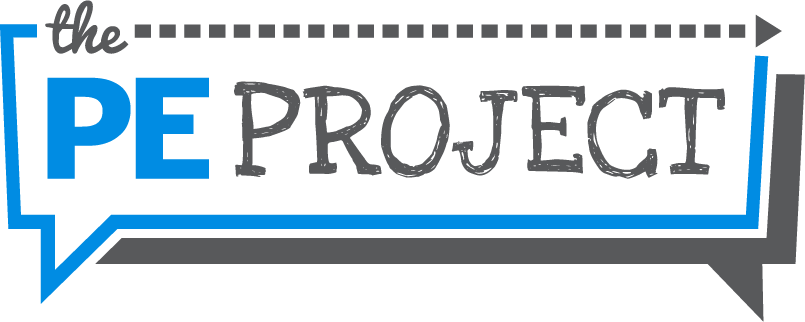
As a PE teacher, effective questioning technique is an essential skill which serves numerous purposes. These include:
- developing listening skills;
- challenging and focusing thinking;
- communicating expectations;
- developing interest and curiosity;
- assessing knowledge and understanding;
- redefining tasks for pupils of differing abilities; and
- helping pupils learn subject-specific terminology in PE [ 1-4 ]

In PE literature the topic of questioning has generally focused on the categorization of convergent and divergent questions and the use of Bloom’s taxonomy for promoting higher-order thinking skills in students. Convergent (or closed) questions generally only have one correct answer which the students should have been taught e.g., “What is a backcourt violation?”. Whereas, divergent (or open) questions allow for more variable and detailed responses e.g., “How could you improve your performance?” [ 1-5 ].

Examples of convergent (closed) and divergent (open) questions
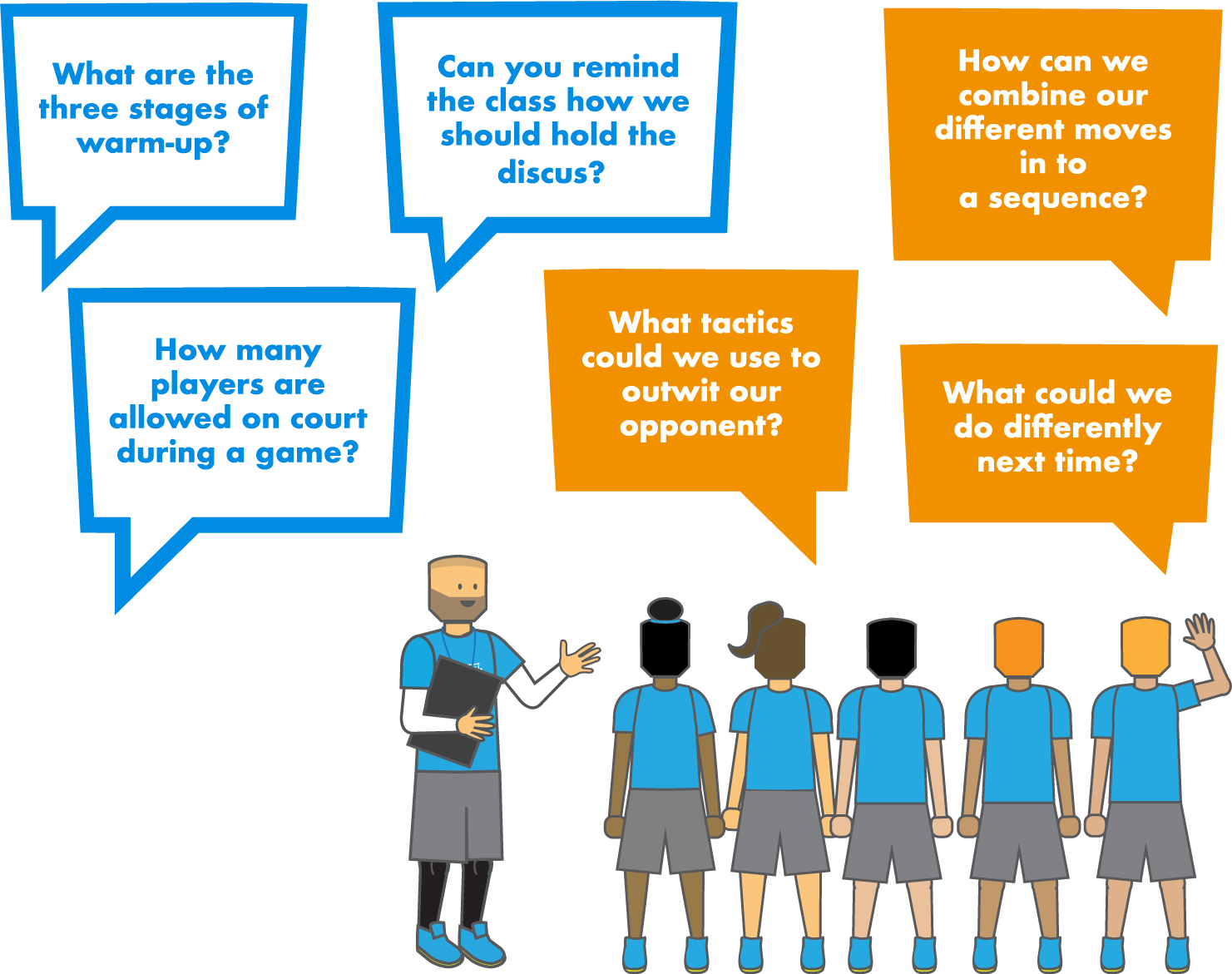
In terms of cognitive complexity, convergent questions usually require lower-order thinking skills whilst divergent questions can stimulate higher-order thinking [ 1 ]. Bloom’s taxonomy of educational objectives provide a useful framework for planning questions which promote higher-order thinking skills (table 1) [ 6 ].
Table 1: Bloom’s taxonomy of higher-order thinking skills used for questioning
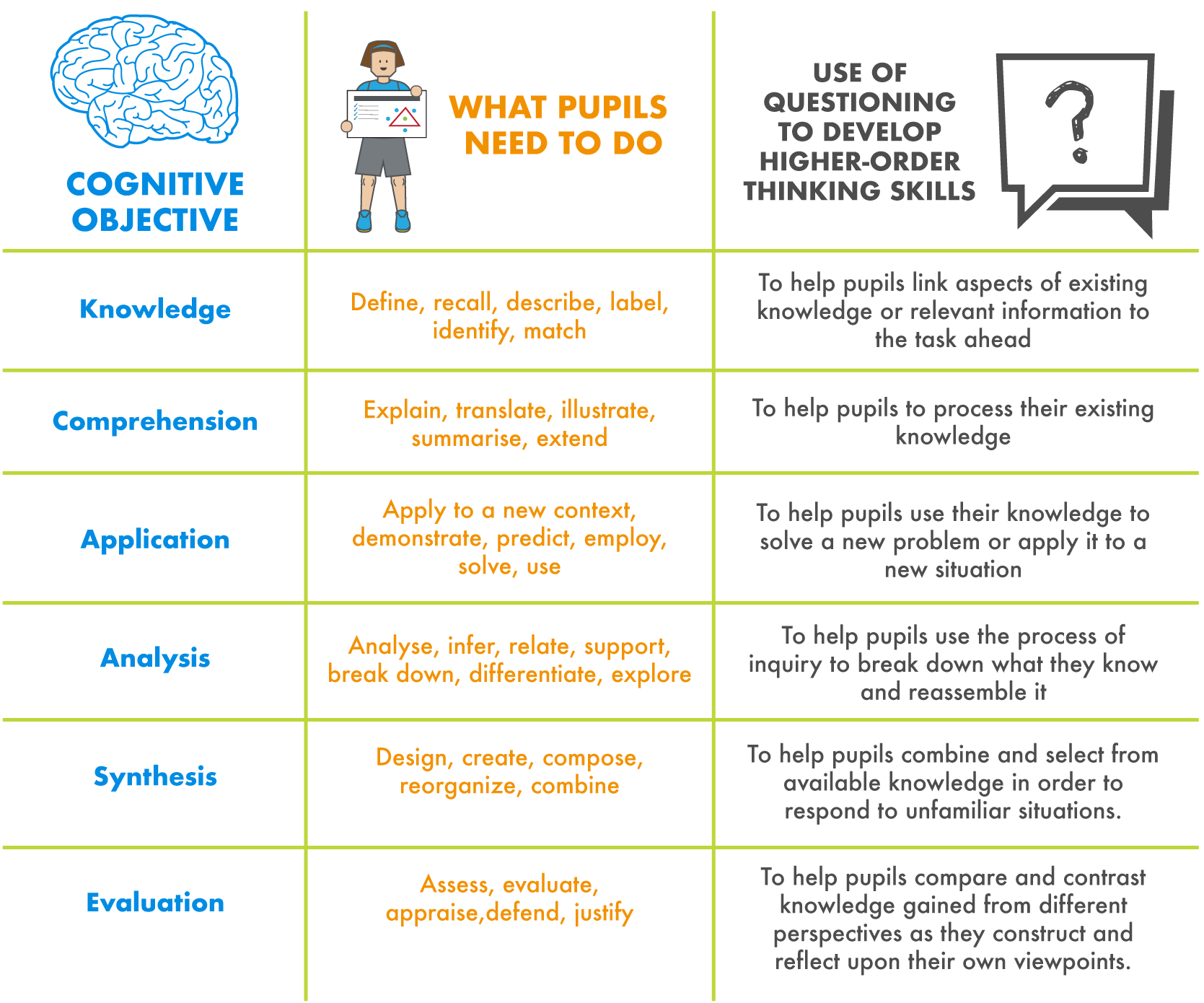
It is important as a PE teacher to plan for both convergent and divergent questions, as lower-order questions encourage students to recall factual knowledge such as recalling the location of muscles or specific teaching points. Whilst higher-order thinking questions might ask students to design a series of exercises that uses the specified muscle [ 1, 7 ]. It is worth noting that you should avoid asking too many divergent questions as they will slow the pace of the lesson [ 2 ]. Therefore, an effective strategy is to focus on the lesson objectives and plan a combination of questions (i.e., 2 closed, 1 open ) which scaffold upon each other [ 8 ].

When asking such questions, Muijs and Reynolds (2011), suggests giving pupils at least 3 seconds thinking time for convergent/closed questions , and 15 seconds for divergent/open questions . One simple strategy to help engage pupils in questioning is 'Think, Pair, Share' - the teacher poses the question and gives pupils thinking time. Students then share their answers with a partner. Teacher then selects students to share answers with the class.
No matter how experienced or inexperienced you are as a teacher, asking effective questions is a skill that can be developed and fine-tuned throughout your teaching career [ 2 ]. If this is a skill that you wish to develop, we recommend that you include relevant questions in your lesson plans and familiarize yourself with the strategies and common mistakes below.
Table 2. Strategies for effective questioning and common mistakes [ 2, 3, 4 ]
.png)
Questions can be asked at any stage during the lesson and doesn’t always have to be in front of the whole-class. A more beneficial approach is to circulate the group and ask individuals and small groups questions to serve a particular purpose, this may be: to focus attention; to invite inquiry; to assess knowledge and understanding; develop self- and peer-assessment; or to lead pupils to be mindful [ 4 ]. Bailey (2001) related question type to the various stages of the lesson (table 3).
Table 3: Types of questions related to stage of the lesson
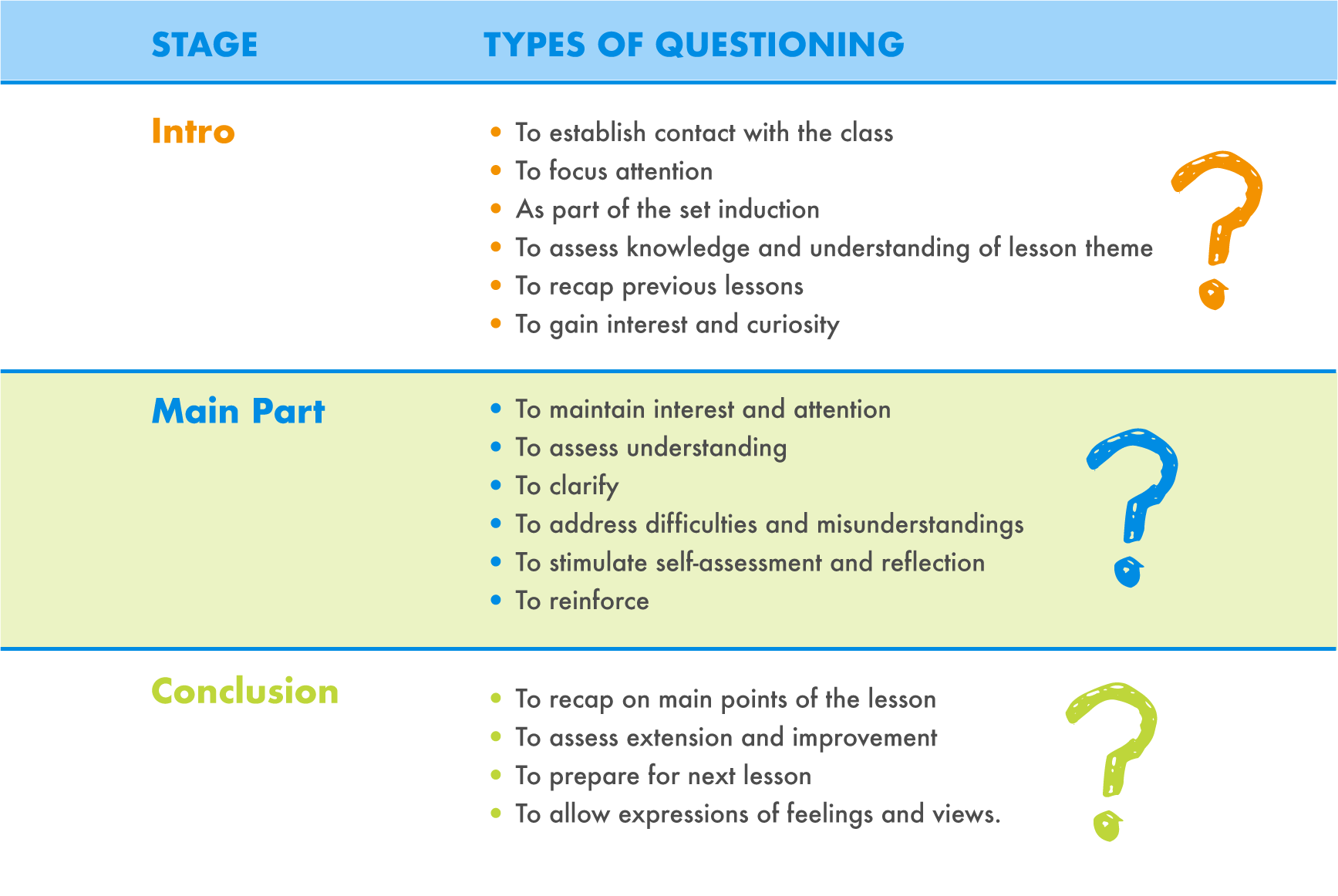
Therefore, in order to skillfully use and ask pertinent questions in Physical Education lessons it is important that you understand and plan a combination of open- and closed- questions which promote the appropriate level of thinking for the different abilities in your class. Print and laminate some of the tables and info above and place them on the wall behind your desk, and try spending 3-minutes thinking about and writing some questions for your lesson. Do this for a handful of lessons in a week and you will be surprised how much better your questioning becomes. But remember to keep it short and punchy!
- Newton, A. & Bowler, M. (2015) Assessment for and of learning in PE, In Capel, S. & Whitehead, M (Ed) Learning to Teach Physical Education in the Secondary School: A Companion to School Experience. 4th Edition. London: Routledge.
- Zwozdiak-Myers, P.N. (2015) Teacher as a researcher/reflective practitioner. In Capel, S. & Whitehead, M (Ed) Learning to Teach Physical Education in the Secondary School: A Companion to School Experience. 4th Edition. London: Routledge.
- Grout, H. & Long, G. (2009) Improving Teaching & Learning in Physical Education. Berkshire: Open University Press
- Bailey, R. (2001) Teaching Physical Education: A handbook for Primary and Secondary School Teachers. London: Kogan Page
- Torrance, H. & Pryor, J. (2001) Developing formative assessment in the classroom: using action research to explore and modify theory. British Educational Research Journal, 27(5): 615-31.
- Bloom, B., Englehart, M.D., Furst, E.J., Hil, W.H. and Krathwohl, D.R. (eds) (1956) Taxonomy of Educational Objectives: The Classification of Educational Goals, Handbook I: Cognitive Domain. New York: D.McKay.
- Good, T.L. & Brophy, J.E.(1991) Looking at Classrooms, Harper Collins: New York.
- Mawer, M (1995) The Effective Teaching of Physical Education, Harlow: Pearson Education.
- Muijs, D. & Reynolds, D. (2011) Effective Teaching: Evidence and Practice. 3rd Edition. London: Sage.
Physical Education Research Digest

Critical Thinking: Creating Meaning in Physical Education (PE) by Denise Dewar and Sue Weir
Denise and Sue are seconded teaching fellows at the University of Edinburgh. While working in schools, they both encountered initiatives aimed at the development of thinking skills. These experiences evolved into a project about ‘critical thinking’ and exploring how these ways of working could be fostered in PE settings and beyond. This blog reports on key insights from their collective self-study that has tracked the impact of their efforts to introduce critical thinking to undergraduate PE students. As part of the PERF’s Practitioner Inquiry (PINQ) Project, their research has been guided by LaBoskey’s key elements for self-study (2004).
Critical Thinking: Creating Meaning in Physical Education (PE)
Critical thinking is an amorphous term (Tan, 2017). It has numerous interpretations on both its definition and on the processes involved in developing critical thinking. Most definitions highlight the connections to the upper three levels of Bloom’s (1956) taxonomy: analysis, synthesis and evaluation. These forms of thinking skills have been associated with a number of ‘Critical thinking’ learner dispositions including; open and fair mindedness, flexibility of thought, inquisitiveness and willingness to take risks (Lai, 2011).
Within the PE literature, critical thinking is a term first popularised by McBride (1992). He viewed PE as an ideal setting to develop critical thinking, which he defined as:
Reflective thinking that is used to make reasonable and defensible decisions about movement tasks or challenges (p112)
The short term focus within this quotation can be seen in the way in which any critical thinking is applied to the immediate tasks and challenges within a class situation. Our own efforts, however, have been geared towards viewing critical thinking from both a short and long term perspective. As can be seen in the figure below (click on image to enlarge), pupils not only respond to unique movement problems and reflect on and justify the decisions they make in class, but are also encouraged to view PE critically as part of their overall physical activity habits and lifestyle.
One key driver for connecting with these longer term ambitions comes from Dewey’s (1933) work on ‘deep’ learning. He explores the connection between ‘thinking’ and ‘meaning’ to create what he termed ‘profound learning’. More recent research with a focus on ‘meaning’ has identified personal experience as a central feature. In the PE context, Beni et al (2016) explain how pupils with personalised experiences can feel more ‘meaningful’ connections to learning tasks, which are more likely to commit to a physically active lifestyle.
Our knowledge of critical thinking initially developed through our reading and shared discussions with each other and with critical friends. Knowledge and understanding was further developed by piloting with the undergraduate PE teachers through lectures, seminars and practical workshops. Our lecture to second year students was included as a key part of the curriculum course and was followed by a seminar which allowed students to discuss their understanding of critical thinking and explore ideas for their teaching of core PE. Within practical workshops, fourth year students reflected on their own wider experiences of dance and chose a ‘purpose’ best suited to them, the students created a group performance based on these personal experiences. They then performed the dance, evaluated the performance collectively and then reflected on the thinking involved in the creative process.
Data were gathered through a mixed methods approach: pre and post workshop questionnaires with students together with our own individual and shared reflections with two experienced teacher educators acting as critical friends throughout the research process. In both years of the project we were surprised by the decisions students made when presented with choices in the lesson. This reinforced our belief in offering pupils opportunities to not only make decisions but also justify these decisions to gain more insight into them (McBride, 1992). Also, in the second year of the project, we felt we were more explicit in teaching thinking skills and dispositions within the workshops and using the language of thinking from the literature. The importance of reflection time was highlighted in collective reflections, as we felt students needed time to make sense of the task and the thinking process.
Student Experiences
From data collected following the second year of workshops all students were able to identify when they used thinking skills and dispositions within the session. We felt this indicated a deeper understanding of the concepts and tied in with our own reflections of being better able to ‘model critical thinking’ (McBride, 1992, p 118).
In harmony with our reflections, students also highly valued pupil reflection as a key component of critical thinking, with over half (52%) indicating that this would be an area of their own practice they would like to enhance.
Most students (93%) thought the session was made ‘meaningful’ with most of them connecting this to being given choices throughout the session, being able to express themselves freely and the nature of the session being sociable and enjoyable.
Concluding thoughts
As an ongoing longitudinal study, we have had some valuable findings so far. The responses from the students have been encouraging, particularly as all students recognise the importance of critical thinking within PE. In addition, as we have grappled with the key critical thinking concepts, our shared reflections have helped us make more sense of the non-linear nature of the design and enactment process of this type of project.
In the future, we will continue to integrate key components of critical thinking in the gymnastics element of curriculum and pedagogy course for year 2 and will reflect individually and collectively on the enactment process. In addition, we will continue to share our critical thinking journey with other practitioners as part of the PINQ project and more widely.
Beni, S, Fletcher T and Ni Chronin, D (2016) Meaningful Experiences in Physical Education and Youth Sport: A review of literature, Quest, DOI: 10.1080/00336297.2016.1224192
LaBoskey, V. K. (2004). The methodology of self-study and its theoretical underpinnings. In J. J. Loughran, M. L. Hamilton, V. K. LaBoskey & T. Russell (Eds.), International handbook of self-study of teaching and teacher education practices (Vol. 2, pp. 817-869). Dordrecht: Kluwer Academic Publishers
Lai, E.R. (2011) Critical thinking: a literature review. Research report. Pearson.
McBride, R. 1992. Critical thinking—An overview with implications for physical education. Journal of Teaching in Physical Education , 11: 112–125.
Tan, C (2017) Teaching Critical thinking: Cultural challenges and strategies in Singapore. British Educational research journal, 43:5 988-1002
Share this post:
Leave a reply cancel reply.
Your email address will not be published. Required fields are marked *
Save my name, email, and website in this browser for the next time I comment.
Activities for Critical Thinking in P.E.
Michael e carpenter.

Critical thinking covers many aspects of thought including planning, reasoning, logic and reflection. Physical education class, or P.E., can incorporate all the aspects of critical thinking in many activities. It is the job of the teacher to make students think about the lessons they are being taught to utilize critical thinking skills.
Explore this article
- Ball in the Bucket
- Sink the Ship
- Cross the Sea
- Capture the Flag
1 Ball in the Bucket
In this activity, break the students into groups of four. Provide the students with one ball and place a bucket at the opposite end of the gym. Have the students design the most creative ways to get the ball into the bucket in four moves. Tell the students that the ball may be kicked, thrown, bounced or hit in any original and creative way. Let the students have some time to plan on how they will accomplish this. After they have come up with a plan, allow some practice time for each group. Let each group rework their plan if necessary. Have the entire class vote on which group had the most creative plan.
2 Sink the Ship
Place mats around the gym at equal distances from each other. Break the students into groups of four. Each team must designate a gopher and three people to stay on the mat. Place four bowling pins around the mats and give each group one to two small balls to start. The goal is to knock off all the pins to "sink" the ship. The three students on the mat must protect the pins while also attacking the other ships. The gophers collect the balls the students on the mats cannot get. The students must work as a team and develop strategies to protect and knock down the other team's pins.
3 Cross the Sea
Break students into groups of five or six. Provide each group with two gym mats. Tell the students that they are on a tropical island and they must cross the gym to return to safety. The gym mats are the boats. The students must work the gym mats across the gym without any of the students falling off the mat. If any student steps off the map the entire group must go back to the start and try again.
4 Capture the Flag
Divide the students into two teams. Give each team a flag and tell them to place it in one corner of the gym. The center line of the gym will divide the two teams. When a player is on their team's side of the line they are safe. When they cross the line they can be tagged and placed in "jail." The jail can be the sidelines or opposite corner of the gym. The students should devise a strategy to take the other team's flag while protecting their own flag at the same time. The team that captures the other team's flag and returns it to their own side is the winner.
- 1 PE Central: Sink the Ship
- 2 The Educator's Reference Desk: Voyage Across the Ocean
- 3 Teacher Vision: Capture the Flag
About the Author
Michael Carpenter has been writing blogs since 2007. He is a mortgage specialist with over 12 years of experience as well as an expert in financing, credit, budgeting and real estate. Michael holds licenses in both real estate and life and health insurance.
Related Articles

Junior High Physical Education Games

Bean Bag Games for PE

Middle School P.E. Games & Activities

5th Grade Team-Building Activities

Fun Physical Education Games for 8th-Graders

Mormon Pioneer Games & Activities

Primary PE Ideas

What Are Some Fun Games to Play at a Youth Rally?

PE Scooter Activities

Kindergarten Sports Activities

PE Station Activities

Paddle or Racket Activities for Elementary P.E.

Parade Flag Etiquette

How to Build Church Altars

What Is the Marine Corps Ship Sea Duty Detachment?

Preschool Force & Motion Ideas

How to Fold a Marine Corps Flag

Games to Teach Perseverance

Bowling Games for Physical Education

How to Build a Miniature Scale of a Roller Coaster...
Regardless of how old we are, we never stop learning. Classroom is the educational resource for people of all ages. Whether you’re studying times tables or applying to college, Classroom has the answers.
- Accessibility
- Terms of Use
- Privacy Policy
- Copyright Policy
- Manage Preferences
© 2020 Leaf Group Ltd. / Leaf Group Media, All Rights Reserved. Based on the Word Net lexical database for the English Language. See disclaimer .
Top Nav Breadcrumb
- Ask a question

Thinking skills in physical education
Thomas Courcoux, primary PE teacher, Atlanta International School, USA
This article demonstrates how the development of thinking skills can help build a bridge between subjects such as physical education and social studies. Through a contemporary dance approach, the author supports students’ creativity and leads them to express their understanding of the unit ‘Sharing the planet’ in a meaningful way.
In physical education (PE) class, we have been using a number of thinking routines to increase engagement and deepen the student’s understanding of a unit of inquiry. Through an overview of my 5th grade during a contemporary dance unit, students discovered how their thinking in PE can be a source of inspiration in order to create their shapes and moves connected to the unit of inquiry Sharing the planet . PE became an integral part of a transdisciplinary learning journey thus building a bridge between classroom teachers and specialists.
With my 5th grade in dance, I wanted them to have a physical experience that goes beyond reproducing shapes, steps and moves. I want them to see their body as a way to express themselves, and therefore I felt that a contemporary dance fits this aim. However, when you tell students and teachers that this dance unit will be based on a contemporary approach, it does not always excite them! How can we reach this goal without taking the risk of having our students becoming unmotivated or blocked? How can the unit of inquiry be a source of inspiration for their dance, and how can the dance lead them to a better understanding about the central idea?
We have been using thinking routines, to help students have ownership of their work, so that they confidently discuss, choose and create their own moves in contemporary dance. This leads them to uncover deeper thinking and express themselves in a meaningful way using their own body.
The central idea for the Sharing the planet unit is “Human migration is a response to challenges, risks, and opportunities”. This unit has been introduced by the classroom teachers through thinking activities using migration pictures displayed in the hallway. In coordination with the classroom teachers, we agreed that in order to get the maximum benefit of this introduction and develop students’ transfer skills, it would be beneficial to use the same thinking routines in PE. So I created a similar gallery in the gym by placing different migrations pictures on gym mats. I asked my students to take post-it notes and move around this gallery to take notes of all the words that were coming to their minds. I used a “I See, Think, Wonder…” routine from Harvard Project Zero , which my students were already familiar with.
Next, my students shared in small groups the words, questions and ideas they came up with. I asked them to keep only four words, so they collectively debated on which words they wanted to keep, which helped them strengthen their collaboration skills.
The following step was to ask my students to create three shapes and one move, each expressing one of the four words. To achieve that, I asked my students to use another thinking routine, “Step inside”, which invited them to “step inside the shoes of a migrant”.
Besides this on-going work in small groups, we came up with the idea of reproducing a migration in the gym. My students stepped in the shoes of a migrant and started to walk slowly around the gym, following each other. This migration walk was the common thread of the 8-minute choreography, and the body shapes and moves were the points of understanding that my students wanted to highlight through this dance unit.
My students performed this dance two times in front of the school community. During the questions and answers session that followed, it was amazing to see how they were able to explain their choices by connecting with their understanding about the central idea. When a grade one student asked “why were you covering your eyes or mouths?”, the fifth grade students connected these body shapes with their understanding about how being a migrant leads to some tough situations we do not want to see, and how you may not have the right to raise your voice.
At the end of the unit, and to reflect on their understanding about the contemporary dance approach in PE, I invited my students to use the thinking routine “I used to think…Now I think…”. I split my whiteboard in two parts, one for “I used to think…” and the second one for “Now I think…”. With two post-it notes, each student wrote their perspectives about contemporary dance before and after this unit. By looking closely at the post-its, the students could realize how their thinking about body expression has shifted. They were more inclined to explore the body as a way to express themselves.
This unit has been inspiring for both students and teachers and brought a rich perspective regarding the role of PE within a transdisciplinary programme. The contemporary approach of the dance, as well as the student agency and the use of thinking routines seem to be some of the key points that led to a successful project.
References:
Harvard Project Zero, from Harvard Graduate School of Education: http://www.pz.harvard.edu/
Creativity routines: Step Inside: Perceive, Know, Care about : A routine for getting inside perspectives
Ritchhart, R, Church, M, & Morrison, K (2011). Making Thinking Visible: How to Promote Engagement, Understanding, and Independence for All Learners
Thomas Courcoux is a French citizen, currently PE teacher at Atlanta International School . He has held several positions in France, India and now in the USA. He holds an ‘agrégation’ in physical education and a bachelor’s in physical education from the University of Rennes-Brittany. He also holds a Master’s of Learning Sciences, Comparative and International Education from the University of Paris-Descartes and has developed a high interest in curriculum comparisons. Thomas enjoys exploring teaching approaches that go beyond teaching physical skills, looking at the student in a holistic approach. You can follow him on Twitter @TomCcx .
PE , physical education , Sharing the planet
3 Responses to Thinking skills in physical education
Inspired! Will share this tomorrow with the PE teacher in the school where I’m teaching a professional development course on thinking strategies and routines tomorrow.
This is amazing — I’m sharing this with my TK-8 staff.
I am the VP of dance for our state organization in Louisiana. I came across your research integrating dance into Physical Education. This is a piece of LAHPERD we are trying to improve. We are currently looking for presenters for our state conference in November 2021. Would you have any recommendations?
Leave a Reply
You must be logged in to post a comment.
This site uses Akismet to reduce spam. Learn how your comment data is processed .
About the IB
The International Baccalaureate (IB) is a global leader in international education—developing inquiring, knowledgeable, confident, and caring young people. With more than 7,700 programmes being offered worldwide, across over 5,600 schools in 159 countries, an IB education is designed to develop well-rounded individuals who can respond to today’s challenges with optimism and an open mind. For over 50 years, our four programmes provide a solid, consistent framework and the flexibility to tailor students’ education according to their culture and context. To find out more, please visit www.ibo.org.
Critical Pedagogy in Physical Education
- Living reference work entry
- First Online: 14 October 2020
- Cite this living reference work entry
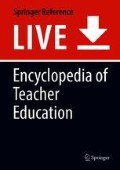
- Shrehan Lynch 2 &
- Alan Ovens 3
109 Accesses
3 Citations
3 Altmetric
This is a preview of subscription content, log in via an institution to check access.
Access this chapter
Institutional subscriptions
Lynch, S., & Curtner-Smith, M. D. (2019a). “The education system is broken:” The influence of a sociocultural foundations class on the perspectives and practices of physical education preservice teachers. Journal of Teaching in Physical Education, 38 (4), 377–387.
Article Google Scholar
Lynch, S., & Curtner-Smith, M. (2019b). ‘You have to find your slant, your groove:’ One physical education teacher’s efforts to employ transformative pedagogy. Physical Education and Sport Pedagogy, 24 (4), 359–372.
Ovens, A. (2016). Chapter 19: Transformative aspirations and realities in physical education teacher education. In C. Ennis (Ed.), Routledge handbook of physical education pedagogies (pp. 295–306). New York: Taylor and Francis.
Google Scholar
Philpot, R., & Ovens, A. (2019). Five principles of transformative pedagogies in PETE. In J. Walton-Fisette, S. Sutherland, & J. Hill (Eds.), Teaching about social justice issues in physical education (pp. 3–12). Information Age Publishing.
Philpot, R., Smith, W., & Ovens, A. (2019). PETE critical pedagogies for a new millennium. Movimento, 25 , e25064. https://doi.org/10.22456/1982-8918.95142 . Porto Alegre.
Download references
Author information
Authors and affiliations.
School of Education and Communities, University of East London, London, UK
Shrehan Lynch
University of Auckland, Auckland, New Zealand
You can also search for this author in PubMed Google Scholar
Corresponding author
Correspondence to Shrehan Lynch .
Editor information
Editors and affiliations.
Faculty of Education, Beijing Normal University, Beijing, Beijing, China
Michael A. Peters
Section Editor information
University of Winchester, Winchester, UK
Emile Bojesen
Institute of Education, University of Winchester, Winchester, UK
Vicky Randall
Rights and permissions
Reprints and permissions
Copyright information
© 2021 Springer Nature Singapore Pte Ltd.
About this entry
Cite this entry.
Lynch, S., Ovens, A. (2021). Critical Pedagogy in Physical Education. In: Peters, M.A. (eds) Encyclopedia of Teacher Education. Springer, Singapore. https://doi.org/10.1007/978-981-13-1179-6_417-1
Download citation
DOI : https://doi.org/10.1007/978-981-13-1179-6_417-1
Received : 04 September 2020
Accepted : 05 September 2020
Published : 14 October 2020
Publisher Name : Springer, Singapore
Print ISBN : 978-981-13-1179-6
Online ISBN : 978-981-13-1179-6
eBook Packages : Springer Reference Education Reference Module Humanities and Social Sciences Reference Module Education
- Publish with us
Policies and ethics
- Find a journal
- Track your research
An official website of the United States government
The .gov means it’s official. Federal government websites often end in .gov or .mil. Before sharing sensitive information, make sure you’re on a federal government site.
The site is secure. The https:// ensures that you are connecting to the official website and that any information you provide is encrypted and transmitted securely.
- Publications
- Account settings
Preview improvements coming to the PMC website in October 2024. Learn More or Try it out now .
- Advanced Search
- Journal List
- Psicol Reflex Crit
- v.35; 2022 Dec
The role of physical activity promoting thinking skills and emotional behavior of preschool children
Changwei wang.
Institute of Physical Education, Ningxia University, Yinchuan, China
Associated Data
Data will be available on request.
Physical activity is critical, not only for the normal growth and development of children, but also for emotional and social behavior. The purpose of the article is to determine the relationship between physical education and social and emotional development of preschool children.
The study involved 366 children (188 boys and 178 girls) at the ages of 5 ( N = 191) and 6 ( N = 174), who study in public kindergartens in Beijing (China). Within 3 months, additional physical education and fitness classes were held. Before and after the study, a test was conducted: Ages & Stages Questionnaires: Social-Emotional (ASQ:SE), which was completed by the parents. The research process did not affect the performance or development of children participants.
As a result of the study, the main regularities of the influence of physical education on social and emotional behavior of children were established. Based on the results of the study, it was determined that there is a positive correlation between age, physical education, and social-emotional behavior ( r +—= 0.668).
Gender differences are not statistically significant when it comes to physical activity’s effect on social and emotional behavior ( p -value = 0.004). The results can be applied to programs for the prevention of psychosocial and social-emotional development delays of children in kindergartens.
Introduction
At present, in the system of scientific knowledge, great attention is paid to the process of physical education of preschool children. At the same time, innovative programs are being developed and new technologies are being introduced (Gordon et al., 2013 ). Regular physical activity during childhood is not only important for maintaining a healthy body weight, but also brings many other physiological and psychosocial benefits (Frank et al., 2018 ). There has long been agreement that regular vigorous physical activity provides psychological benefits such as reduced symptoms of depression, the creation of more positive mood states, reduced levels of anxiety, and increased self-esteem in both adults and adolescents, but there is not much information on such effects in young children (Timmons et al., 2007 ).
Performing physical exercises is accompanied by intense emotional experiences caused by the struggle for the best result. In the process of physical education, the child masters a variety of thinking skills (Mutohir et al., 2019 ). Unfortunately, the number of children not participating in adequate physical activity continues to be a concern worldwide. The decisive aspect of physical education is the purposeful formation of a conscious, based on deep knowledge and beliefs, motivation of physical training, a stable habit of constantly taking care of one’s health, and instilling skills in organizing daily physical activity (Kain et al., 2017 ). In modern society, there is an underestimation of the role of physical education in the formation of the integral personality (Rodriguez-Ayllon et al., 2019 ). Lack of motor activity, muscle weakness, and limited motor skills and abilities lead not only to a child’s loss of physical health, but also to the impossibility of the full-fledged formation of his/her intellectual and emotional components (Cairney et al., 2019 ). It is very important for preschoolers to engage in any high-intensity physical activity for at least 1 h a day. Up to 6 years old, their body grows every day (Roscoe et al., 2019 ). Physical activity improves their overall health and is essential for developing healthy habits for life. In addition, physical activity has several benefits for children. It makes them realize the importance of working together, meeting new people, and developing thinking skills (Gao et al., 2019 ). Physical activity includes physical exercises, walks outside, outdoor games, and training. Outdoor games are the most accessible and effective method of influencing a child. The advantage of outdoor games over sole exercises is that a game is always associated with initiative, individual imagination and requires independence to achieve a game result and responsibility to a team (Schembri et al., 2019 ). A healthy and active child is automatically self-confident and dignified. Physical activity improves the overall level of concentration, allows children to cope better with anxiety and stress, and improves motor skills and brain development (Burns et al., 2017 ; Lubans et al., 2016 ). Children who do not receive adequate instruction and practice in motor skills may have a delay in their development (Stagnitti et al., 2011 ). Social-emotional development of preschoolers is one of the basic components of mental health. Physical culture means can be used to stabilize the emotional response when interacting with the environment (Denham et al., 2015 ). Based on a literature review, a child’s social competence was defined as the ability to establish and maintain social contacts in the process of interaction based on a positive attitude towards oneself, and emotional competence is the ability to experience emotions, understand one’s own emotions and the emotions of other people, and regulate their expression (Franco et al., 2017 ). Research on early childhood points to the concept of emotional competence, skills, and behaviors in children associated with emotions such as expression, awareness, labeling, and understanding of emotions based on emotional facial expressions and contextual cues (Kılıç, 2015 ). The concept of social-emotional competence (SEC) seems the most integrative as a set of additional abilities:
- Self-awareness, which describes the knowledge of one’s strengths and weaknesses and distinction of emotions.
- Empathy—the ability to recognize, understand, and compassionate the feelings of another and the desire to influence them positively.
- Motivation indicates the ability to stay involved in an activity, even if it is difficult or the previous experience was partially related to failure (Costa et al., 2020 ).
- Self-regulation, which is the conscious control of impulsive and inappropriate reactions and inappropriate expressions of emotion (Weare, 2004 ).
- Thinking skills that include a wide range of knowledge, abilities, and competencies, including the ability to develop and maintain healthy relationships, participate in social activities, and interact with people correctly (Aubrey et al., 2012 ).
In addition, research highlights the need to use critical thinking to predict positive gains such as adjusting to school and developing positive attitudes, academic performance, attachment, and social behavior (Fernández-Santín & Feliu-Torruella, 2020 ). In addition to the personal characteristics of preschoolers, external factors (family, educator, country) influence the formation of critical thinking (Breaux et al., 2016 ).
Teachers need to have knowledge about thinking skills, know how to teach those skills through activities including thinking skills, become aware of the difficulties that learners may encounter, and develop preventive methods for those difficulties in order to enable learners to become effective thinkers rather than transferring knowledge to their learners (Akinoglu & Karsantik, 2016 ).
Definitely, it is difficult for a child to go through the entire process of socialization on his/her own. The role of parents, teachers, and the environment is great for this. An active game can help in this—an activity that is close to children in perception and images. It carries a great pedagogical value (Domitrovich et al., 2007 ). Topics related to the influence of physical activity on the psychoemotional state of preschool children had been previously studied. At the same time, there are few studies devoted to the analysis of the connection between physical education and social and emotional development of preschoolers. For this reason, this research is considered relevant and innovative.
The significant influence of physical activity and motor experience on the cognition of the world around young children has recently been associated with the effects of neurotrophic brain plasticity (Lippi et al., 2020 ; Miskolczi et al., 2019 ). At the age of up to 5 years, the activation of neuron growth is largely stimulated by motor activity. However, as evidenced by a number of studies, from an older age, social factors of communication and socialization processes begin to increasingly significantly dominate the processes of formation of a child’s cognitive functions (Miskolczi et al., 2019 ; Ploughman, 2008 ). However, studies on the elderly suggest that targeted and increased physical activity can trigger the mechanisms of neurotrophic plasticity at any age (Cho & Roh, 2019 ). Therefore, the main question of the study presented here is whether it is possible only by increasing the amount of ordinary physical activity of the type of movements familiar and studied by the child to enhance the development of cognitive capabilities, in particular, critical thinking.
In accordance with the purpose of this study, the following tasks were set:
- Determining the relationship between physical education classes and critical thinking
- Identifying social and emotional problems of young children before and after intensive physical education classes
- Determining the impact of gender and age differences among study participants on physical activity
Materials and methods
Ethical issues.
Participation in the study was voluntary and with the parents’ permission who completed the consent form. The research process did not affect the performance or development of children participants. No personal data of the participants were collected, stored, or used during the study. The author declares that the work is written with due consideration of ethical standards. The study was conducted in accordance with the ethical principles approved by the author’s university (Protocol No 3 of 15.02.2019).
Participants
The study involved 366 children (188 boys and 178 girls) aged 5 ( N = 191) and 6 ( N = 174) years old who study in public kindergartens in Beijing (China). Other 113 children were excluded due to lack of parental consent for the study.
Participants were selected at random. An invitation to participate, guarantees of anonymity, and an explanation of the reasons and objectives of the study were provided to the parents of the participating children. Information about the child participants was voluntarily provided by their parents after their consent to participate in the study.
Intervention
The research was carried out for 2 months. Children took part in rhythmic and physical education classes, which, in contrast to the adopted state educational program for preschool institutions, were held every day. Before and after the study, the tests were conducted.
As a basis for the intensification of physical education, the training program already familiar and adapted by these children, practiced in their kindergartens, was taken. This program is common to public kindergartens in Beijing, which eliminates the need for additional education or training for the staff training children. This program uses 3 days a week for 40 min of classes; during the lesson, rhythmic exercises are used to the music and at the expense of the teacher, as well as gymnastic exercises, including simple squats; bends; turns; warm-up of the joints of the arms and legs with circular movements of small, medium, and increasing amplitude; various types of running in a circle; and jumping in place. Rhythmic exercises include dancing or a series of isolated simple dance and gymnastic movements aimed at developing a sense of rhythm, increasing coordination and accuracy of orientation in space. The exercises are performed by all children at the same time under the guidance of a teacher. The session is usually broken down into 2 or 3 sequences, separated by rest and free play, breathing exercises, or quiet sitting and relaxation.
The intensification program (intervention) consisted of three significant changes. (1) The lessons described above were necessarily carried out every day. (2) As breaks between sequences during classes, only purposeful breathing exercises or deliberate relaxation while sitting under the guidance of a trainer was used. (3) After the end of physical classes, children were necessarily given a break of at least 30 min for games, distraction, personal activities, and recovery.
These changes were selected on the basis of the recommendations of doctors supervising the children in these kindergartens in order to maintain health and not exceed the permissible loads on the body of children.
The increase in cognitive abilities was equally dependent on the increase in the amount of physical activity and social interaction of children, because the classes were conducted in a group. The significance of the impact of physical movement should be assessed as a more significant factor, since the amount and quality of social interaction for children did not actually change over this time (Miskolczi et al., 2019 ). The need to take into account the effects of neurotrophic plasticity in this case is reduced, because at the age of 5 years, their role naturally decreases, and the role of motor activity and social interaction increases (Lippi et al., 2020 ).
Ages & Stages Questionnaires: Social-Emotional (ASQ:SE) with sets of questions for children 5 and 6 years old (Squires et al., 2002 ) was used. The questionnaire contains 33 questions, each of which characterizes a specific aspect of a child’s behavior: self-regulation, compliance, communication, adaptive behaviors, autonomy, affect, and interaction with people (Squires et al., 2002 ). The following options were offered: “most of the time” = 0 points, “sometimes” = 5 points, “rarely or never” = 10 points, and “checked concern” = 5 additional points. In ASQ-SE, lower scores indicate more positive results. If the child’s overall score exceeds the threshold of 70, this means that additional mental health assessment may be required. The more points the test gets, the higher the risk of delays in the emotional and social development of the child it shows (Squires et al., 2002 ). The study used the mean values for the control and experimental groups.
The Cornell Critical Thinking Test (CCTT) is one of the many multiple-choice tests with validated questions that have been reported to measure general critical thinking (CT) ability. Level X is a 71-item, multiple-choice test for students in grades 5–12 + (Ennis et al., 2005 ; Leach et al., 2020 ). It may be administered as a 50-min timed or as an untimed evaluation. There are three possible answers. The max score is 71.
These tests are used because of their widespread use in the practice of social workers, child psychologists, and academic practice. Their validity and applicability have been repeatedly confirmed, including in the framework of empirical studies (Aizikovitsh-Udi & Cheng, 2015 ; Ennis, 2018 ; Heo & Squires, 2012 ; Kwan & Wong, 2015 ). The test has numerous national adaptations (Alvarez-Nuñez et al., 2020 ; Chen et al., 2017 ).
Each of the two tests used in the study was conducted in the present but without the active participation of the parents, which provided calmness, confidence, and support for the children during the test. The tests were carried out on separate days so as not to overwhelm the children. Before the start of the test, the children were introduced to it and explained in detail the meaning of each question, if any questions arose. On average, tests took from 30 min to 1 h; all questionnaires were successfully completed by participants; no questionnaire was subsequently rejected for any reason.
The survey was conducted with the participation of researchers and a number of student volunteers who have experience in interacting with children of the appropriate age. The questionnaires were completed by researchers and volunteers according to the children’s responses. Before entering the answer to the questionnaire, the researchers and volunteers had to make sure that the child correctly understood the content of the question on the questionnaire. If the child needed a short break for rest, then he/she definitely received it.
Data analysis
Correlation analysis (Pearson) was used to study the relationship between age and the level of critical thinking of children. Data were analyzed using SPSS Statistics version 10. For pre- and post-ASQ:SE test results, the mean of the test and the sample standard deviation were examined. Student’s t -test was also used ( p < 0.05) to check the equality of the mean values in the two samples. A correlation analysis and Student’s t -test were conducted to compare the pre-test and post-test results for the groups of boys and girls separately and for children aged 5 and 6 (Table (Table3). 3 ). Thus, the null hypothesis was tested that the use of physical culture does not affect the critical thinking of children. The margin of error was 2.9%. Some of the questionnaires were not filled out correctly (for example, some respondents did not answer all the questions of the questionnaire).
Statistical evaluation results for the gender and age criteria
Research limitation
The studies were carried out among children who are raised in urban kindergartens and did not take into account the countryside. Social status and racial differences were not taken into account. The study also covers a group of preschoolers between 5 and 6 years old, which limits the ability to draw conclusions for other groups of children, since the level of development and social-emotional problems and thinking skills at different levels of child development differs.
According to the research results, the average value of critical thinking does not exceed the threshold value of 70 points. A detailed analysis is presented in Table Table1 1 .
Statistical evaluation results of the Cornell Critical Thinking Test (CCTT) for pre- and post-test
p < 0.05
The results show (Table (Table1) 1 ) that there is a statistical significance ( p -value = 0.049) between physical education and the level of critical thinking of 5- and 6-year-old children. After completing an enhanced course of physical education, the average value of the post-test decreased by 16 points. This result goes far beyond the margin of error (standard deviation in the sample). A decrease in the test indicator indicates a decrease in the risks of delaying the critical thinking development of children by means of physical education. According to the test results, there is a positive and strong correlation (0.675) between the Cornell Critical Thinking Test and physical activity. It should be recognized that well-planned physical activity has a positive effect on the development of critical thinking.
Table Table2 2 presents the characteristics of social-emotional problems before and after the experiment.
Statistical evaluation results of ASQ:SE for pre- and post-tests (for each test component)
In general, the results show statistically significant indicators for each characteristic. Besides, the data obtained indicate that after 3 months of physical education according to the enhanced program, the performance of children in all main aspects of emotional and social criteria increased in a positive direction. Physical activity has the most significant effect on interaction with people ( p < 0.051). In addition, according to the results, physical education improves communication skills ( p < 0.045) and promotes better adaptability to external factors ( p < 0.047). Sports activities have the least impact on the autonomy of children, p < 0.028, while the indicator is within the limits of statistical significance. In addition, it should be noted that before physical education, children had more perceptible problems with communication (10.1), adaptation to the external environment (10.4), and interconnection with people (11.8), as evidenced by a fairly high average score for these indicators. There are also less significant problems, such as shifting attention from one activity to another, the ability to self-organize, and the ability to play alone.
CCTT test results by age and gender are presented in Table Table3 3 .
The p -value for age and gender categories was determined for the post-test. The results of the study by gender and age generally repeat the CCTT indicators for the entire sample.
Gender differences are not statistically significant when it comes to the physical activity effect ( p -value = 0.004). In turn, age is statistically significant ( p -value = 0.022) for the critical thinking of children. Older children have a better level of critical thinking, as evidenced by the results of the post-test. The indicator for 6-year-old children is 5.2 points lower than for 5-year-olds. Regardless of gender, improvement in critical thinking correlates with increased physical education. At the same time, the correlation is not significantly different for girls (0.654) and boys (0.659).
There is also a fairly strong correlation between the pre-test and post-test results for children 5 and 6 years old. However, for children aged 6 years, the correlation is stronger (0.701) than for children aged 5 (0.645). What is the reason for this phenomenon is a question for further research.
This study showed that physical activity has a positive effect on social and emotional well-being. It should be noted that a child’s age influences critical thinking development. Research has shown that indicators of critical thinking improve for 6-year-olds. Overall, this study confirms the positive impact of physical activity on the emotional and social states of children. The post-test results improved by an average of 4 points on all criteria, which is statistically significant since it goes beyond the margin of error (standard deviation in the sample). This indicator allows one to conclude that children who were immersed in an environment of increased physical activity through daily physical education, outdoor games, and rhythmic improved their mood and became happier. In addition, preschoolers have ceased to conflict and throw tantrums. In accordance with the results of the test on the criterion of interaction with people, after a long period of intensive physical education, children prefer group games and react more positively to new people. The results of the communication characteristic in the post-test decreased by almost 5 points, which testifies to the fact that due to physical activity, children can more easily make new acquaintances and become more sociable. The results of the post-test showed that children became more independent and responsible.
The current study found that gender differences are not statistically significant when it comes to physical activity’s effect on the critical thinking of boys and girls, unlike age which has a significant difference. There is a positive correlation between age, physical activity, and critical thinking ( r +—= 0.668). The results of the study do not directly resonate with the work of other authors but receive additional confirmation in a number of studies. Similar studies showed that active children were more energetic and restless, less inhibited, less compliant, less shy, more assertive, more competitive, and more manipulative than their less active peers (Rodriguez-Ayllon et al., 2019 ). Scientists note that physical activity and outdoor games increase the level of critical thinking (Hyndman et al., 2020 ; Ip et al., 2016 ). In contrast to the present study, some studies have noted gender differences. Namely, emotional and psychological problems in boys are easier to observe since they are more pronounced and therefore more reported by their parents (Maguire et al., 2016 ). Research on the emotional development of children shows that teachers play an important role in recognizing and regulating children’s emotions; teachers are considered quite important role models in terms of how children express emotions (Roberts et al., 2016 ). According to the results of a survey of Chinese physical culture specialists, 29.6% of respondents believe that physical education is a process of mastering the means and methods of physical culture, 27.2% that it is the education of moral and volitional qualities, and only 2.3% that it is a training process. The majority of respondents, 40.9%, agree that the process of physical education is nothing more than a process of education, and, in the opinion of the respondents, employees of the relevant state administration should determine the directions and content of physical education (42.2%), as well as scientists (25.8%) and teachers (32%). One of the factors influencing the effectiveness of this process is determined by a complex of pedagogical conditions—the enrichment of the basic forms and methods of physical education (Truelove et al., 2020 ). Several studies (meta-analysis) have found that physical activity may be associated with an increased cognitive performance during childhood. A positive association was found between physical activity and cognitive function, which includes motor skills, IQ, academic achievement, verbal and math tests, developmental level, and critical thinking in school-aged children (Hujar & Matthews, 2021 ; Yates & Twigg, 2017 ).
Some studies recommend increasing physical activity and play time for preschool children (Chaddock-Heyman et al., 2013 ). The development of the emotional sphere of older preschool children in the process of communicating with peers is determined by the type of situational communication and the prevailing experience of communicating with peers, the ability to choose constructive ways of solving problem situations in the process of communication (Scrimgeour et al., 2016 ).
The problem of the social and emotional development of children is relevant at all times. Teachers need to know what points to pay attention to when raising children and what means to use in this case. The literature analysis showed that the role of physical education in the formation of critical thinking is underestimated. The aim of the study was to try to establish a link between physical education, social-emotional behavior, and critical thinking of preschool children using the example of Beijing (China). Based on the results of the study, it was determined that there is a positive correlation between age, physical education, and critical thinking ( r +—= 0.668). It was found that gender does not have a statistical significance when it comes to the effect of physical activity on the critical thinking of children ( p -value21 = 0.004). In turn, the age of a child is important since statistically significant differences were found ( p -value = 0.022). Also, it was determined that physical education has a positive effect on the emotional and social behavior of preschoolers. A practically significant contribution and novelty of this study is the provision of experience of a significant improvement in the results of critical thinking tests in children only with the intensification of already existing and tested programs of physical development, taking into account proper rest and rhythm of classes, even without using specialized additional methods of physical development.
Acknowledgements
Not applicable.
Code availability
Authors’ contributions.
The author(s) read and approved the final manuscript.
The author did not receive support from any organization for the submitted work.

Availability of data and materials
Declarations.
The author declares that the work is written with due consideration of ethical standards. The study was conducted in accordance with the ethical principles approved by the Ethics Committee of Ningxia University (Protocol No 3 of 15.02.2019).
All participants gave their written informed consent.
The author declares that there are no competing interests.
Publisher’s Note
Springer Nature remains neutral with regard to jurisdictional claims in published maps and institutional affiliations.
- Aizikovitsh-Udi E, Cheng D. Developing critical thinking skills from dispositions to abilities: Mathematics education from early childhood to high school. Creative Education. 2015; 6 (04):455. doi: 10.4236/ce.2015.64045. [ CrossRef ] [ Google Scholar ]
- Akinoglu O, Karsantik Y. Pre-service teachers’ opinions on teaching thinking skills. International Journal of Instruction. 2016; 9 (2):61–76. doi: 10.12973/iji.2016.925a. [ CrossRef ] [ Google Scholar ]
- Alvarez-Nuñez L, González M, Rudnitzky F, Vásquez-Echeverría A. Psychometric properties of the Spanish version of the Ages & Stages Questionnaires: Social-Emotional in a nationally representative sample. Early Human Development. 2020; 149 :105157. doi: 10.1016/j.earlhumdev.2020.105157. [ PubMed ] [ CrossRef ] [ Google Scholar ]
- Aubrey C, Ghent K, Kanira E. Enhancing thinking skills in early childhood. International Journal of Early Years Education. 2012; 20 (4):332–348. doi: 10.1080/09669760.2012.743102. [ CrossRef ] [ Google Scholar ]
- Breaux RP, Harvey EA, Lugo-Candelas CI. The role of parent psychopathology in emotion socialization. Journal of Abnormal Child Psychology. 2016; 44 (4):731–743. doi: 10.1007/s10802-015-0062-3. [ PMC free article ] [ PubMed ] [ CrossRef ] [ Google Scholar ]
- Burns RD, Fu Y, Podlog LW. School-based physical activity interventions and physical activity enjoyment: A meta-analysis. Preventive Medicine. 2017; 103 :84–90. doi: 10.1016/j.ypmed.2017.08.011. [ PubMed ] [ CrossRef ] [ Google Scholar ]
- Cairney J, Dudley D, Kwan M, Bulten R, Kriellaars D. Physical literacy, physical activity and health: Toward an evidence-informed conceptual model. Sports Medicine. 2019; 49 (3):371–383. doi: 10.1007/s40279-019-01063-3. [ PubMed ] [ CrossRef ] [ Google Scholar ]
- Chaddock-Heyman L, Erickson KI, Voss M, Knecht A, Pontifex MB, Castelli D, Hillman CH, Kramer A. The effects of physical activity on functional MRI activation associated with cognitive control in children: A randomized controlled intervention. Frontiers in Human Neuroscience. 2013; 7 :72. doi: 10.3389/fnhum.2013.00072. [ PMC free article ] [ PubMed ] [ CrossRef ] [ Google Scholar ]
- Chen CY, Xie H, Filgueiras A, Squires J, Anunciação L, Landeira-Fernandez J. Examining the psychometric properties of the Brazilian Ages & Stages Questionnaires-Social-Emotional: Use in public child daycare centers in Brazil. Journal of Child and Family Studies. 2017; 26 (9):2412–2425. doi: 10.1016/j.earlhumdev.2020.105157. [ CrossRef ] [ Google Scholar ]
- Cho SY, Roh HT. Taekwondo enhances cognitive function as a result of increased neurotrophic growth factors in elderly women. International Journal of Environmental Research and Public Health. 2019; 16 (6):962. doi: 10.3390/ijerph16060962. [ PMC free article ] [ PubMed ] [ CrossRef ] [ Google Scholar ]
- Costa S, Bianco A, Polizzi V, Alesi M. Happiness in physical activity: A longitudinal examination of children motivation and negative affect in physical activity. Journal of Happiness Studies. 2020; 22 (4):1643–1655. doi: 10.1007/s10902-020-00289-7. [ CrossRef ] [ Google Scholar ]
- Denham SA, Bassett HH, Wyatt T. The socialization of emotional competence. In: Grusec JE, Hastings PD, editors. Handbook of socialization: Theory and research. New York: The Guilford Press; 2015. pp. 590–613. [ Google Scholar ]
- Domitrovich CE, Cortes RC, Greenberg MT. Improving young children’s social and emotional competence: A randomized trial of the preschool “PATHS” curriculum. The Journal of Primary Prevention. 2007; 28 (2):67–91. doi: 10.1007/s10935-007-0081-0. [ PubMed ] [ CrossRef ] [ Google Scholar ]
- Ennis RH. Critical thinking across the curriculum: A vision. Topoi. 2018; 37 (1):165–184. doi: 10.1007/s11245-016-9401-4. [ CrossRef ] [ Google Scholar ]
- Ennis RH, Millman J, Tomko TN. The Cornell Critical Thinking Tests, Level X and Z (revised) Midwest Publication; 2005. [ Google Scholar ]
- Fernández-Santín M, Feliu-Torruella M. Developing critical thinking in early childhood through the philosophy of Reggio Emilia. Thinking Skills and Creativity. 2020; 37 :100686. doi: 10.1016/j.tsc.2020.100686. [ CrossRef ] [ Google Scholar ]
- Franco MDG, Beja MJ, Candeias A, Santos N. Emotion understanding, social competence and school achievement in children from primary school in Portugal. Frontiers in Psychology. 2017; 8 :1376. doi: 10.3389/fpsyg.2017.01376. [ PMC free article ] [ PubMed ] [ CrossRef ] [ Google Scholar ]
- Frank ML, Flynn A, Farnell GS, Barkley JE. The differences in physical activity levels in preschool children during free play recess and structured play recess. Journal of Exercise Science & Fitness. 2018; 16 (1):37–42. doi: 10.1016/j.jesf.2018.03.001. [ PMC free article ] [ PubMed ] [ CrossRef ] [ Google Scholar ]
- Gao Z, Zeng N, Pope ZC, Wang R, Yu F. Effects of exergaming on motor skill competence, perceived competence, and physical activity in preschool children. Journal of Sport and Health Science. 2019; 8 (2):106–113. doi: 10.1016/j.jshs.2018.12.001. [ PMC free article ] [ PubMed ] [ CrossRef ] [ Google Scholar ]
- Gordon ES, Tucker P, Burke SM, Carron AV. Effectiveness of physical activity interventions for preschoolers: A meta-analysis. Research Quarterly for Exercise and Sport. 2013; 84 (3):287–294. doi: 10.1080/02701367.2013.813894. [ PubMed ] [ CrossRef ] [ Google Scholar ]
- Heo KH, Squires J. Cultural adaptation of a parent completed social emotional screening instrument for young children: Ages and stages questionnaire-social emotional. Early Human Development. 2012; 88 (3):151–158. doi: 10.1016/j.earlhumdev.2011.07.019. [ PubMed ] [ CrossRef ] [ Google Scholar ]
- Hujar J, Matthews MS. Teacher perceptions of the primary education thinking skills program. Roeper Review. 2021; 43 (3):187–196. doi: 10.1080/02783193.2021.1923594. [ CrossRef ] [ Google Scholar ]
- Hyndman B, Winslade M, Wright B. Health and Education Interdependence. Singapore: Springer; 2020. Physical activity and learning; pp. 179–204. [ Google Scholar ]
- Ip P, Rao N, Bacon-Shone J, Li SL, Ho FKW, Chow CB, Jiang F. Socioeconomic gradients in school readiness of Chinese preschool children: The mediating role of family processes and kindergarten quality. Early Childhood Research Quarterly. 2016; 35 :111–123. doi: 10.1016/j.ecresq.2015.10.005. [ CrossRef ] [ Google Scholar ]
- Kain J, Leyton B, Concha F, Close M, Soto-Sánchez J, Salazar G. Preschool children’s physical activity intensity during school time: Influence of school schedule. Preventive Medicine Reports. 2017; 8 :6–9. doi: 10.1016/j.pmedr.2017.07.011. [ PMC free article ] [ PubMed ] [ CrossRef ] [ Google Scholar ]
- Kılıç S. Emotional competence and emotion socialization in preschoolers: The viewpoint of preschool teachers. Educational Sciences: Theory & Practice. 2015; 15 (4):1007–1020. doi: 10.12738/estp.2015.4.2529. [ CrossRef ] [ Google Scholar ]
- Kwan YW, Wong AF. Effects of the constructivist learning environment on students’ critical thinking ability: Cognitive and motivational variables as mediators. International Journal of Educational Research. 2015; 70 :68–79. doi: 10.1016/j.ijer.2015.02.006. [ CrossRef ] [ Google Scholar ]
- Leach SM, Immekus JC, French BF, Hand B. The factorial validity of the Cornell Critical Thinking Tests: A multi-analytic approach. Thinking Skills and Creativity. 2020; 37 :100676. doi: 10.1016/j.tsc.2020.100676. [ CrossRef ] [ Google Scholar ]
- Lippi G, Mattiuzzi C, Sanchis-Gomar F. Updated overview on interplay between physical exercise, neurotrophins, and cognitive function in humans. Journal of Sport and Health Science. 2020; 9 (1):74–81. doi: 10.1016/j.tics.2013.08.001. [ PMC free article ] [ PubMed ] [ CrossRef ] [ Google Scholar ]
- Lubans D, Richards J, Hillman C, Faulkner G, Beauchamp M, Nilsson M, Biddle S. Physical activity for cognitive and mental health in youth: A systematic review of mechanisms. Pediatrics. 2016; 138 (3):e20161642. doi: 10.1542/peds.2016-1642. [ PubMed ] [ CrossRef ] [ Google Scholar ]
- Maguire LK, Niens U, McCann M, Connolly P. Emotional development among early school-age children: Gender differences in the role of problem behaviours. Educational Psychology. 2016; 36 (8):1408–1428. doi: 10.1080/01443410.2015.1034090. [ PMC free article ] [ PubMed ] [ CrossRef ] [ Google Scholar ]
- Miskolczi C, Halász J, Mikics É. Changes in neuroplasticity following early-life social adversities: The possible role of brain-derived neurotrophic factor. Pediatric Research. 2019; 85 (2):225–233. doi: 10.1038/s41390-018-0205-7. [ PubMed ] [ CrossRef ] [ Google Scholar ]
- Mutohir TC, Kusnanik NW, Hidayati S, Mukminin A. Critical thinking skills based of physical activities learning model for early childhood. The Journal of Social Sciences Research. 2019; 5 (3):738–755. [ Google Scholar ]
- Ploughman M. Exercise is brain food: The effects of physical activity on cognitive function. Developmental Neurorehabilitation. 2008; 11 (3):236–240. doi: 10.1080/17518420801997007. [ PubMed ] [ CrossRef ] [ Google Scholar ]
- Roberts A, LoCasale-Crouch J, Hamre B, DeCoster J. Exploring teachers’ depressive symptoms, interaction quality, and children’s social-emotional development in Head Start. Early Education and Development. 2016; 27 (5):642–654. doi: 10.1080/10409289.2016.1127088. [ CrossRef ] [ Google Scholar ]
- Rodriguez-Ayllon M, Cadenas-Sanchez C, Estevez-Lopez F, Munoz NE, Mora-Gonzalez J, Migueles JH, Molina-García P, Henriksson H, Mena-Molina A, Martínez-Vizcaíno V, Catena A, Löf M, Erickson KI, Lubans DR, Ortega FB, Esteban-Cornejo I. Role of physical activity and sedentary behavior in the mental health of preschoolers, children and adolescents: A systematic review and meta-analysis. Sports Medicine. 2019; 49 :1383–1410. doi: 10.1007/s40279-019-01099-5. [ PubMed ] [ CrossRef ] [ Google Scholar ]
- Roscoe CM, James RS, Duncan MJ. Accelerometer-based physical activity levels, fundamental movement skills and weight status in British preschool children from a deprived area. European Journal of Pediatrics. 2019; 178 (7):1043–1052. doi: 10.1007/s00431-019-03390-z. [ PMC free article ] [ PubMed ] [ CrossRef ] [ Google Scholar ]
- Schembri R, Quinto A, Aiello F, Pignato S, Sgrò F. The relationship between the practice of physical activity and sport and the level of motor competence in primary school children. Journal of Physical Education and Sport. 2019; 19 :1994–1998. doi: 10.7752/jpes.2019.s5297. [ CrossRef ] [ Google Scholar ]
- Scrimgeour MB, Davis EL, Buss KA. You get what you get and you don’t throw a fit!: Emotion socialization and child physiology jointly predict early prosocial development. Developmental Psychology. 2016; 52 (1):102–116. doi: 10.1037/dev0000071. [ PMC free article ] [ PubMed ] [ CrossRef ] [ Google Scholar ]
- Squires J, Bricker D, Twombly E. Ages and stages questionnaires: Social-emotional. Baltimore: Brookes; 2002. [ Google Scholar ]
- Stagnitti K, Malakellis M, Kenna R, Kershaw B, Hoare M, de Silva-Sanigorski A. Evaluating the feasibility, effectiveness and acceptability of an active play intervention for disadvantaged preschool children: A pilot study. Australian Journal of Early Childhood. 2011; 36 (3):66–72. doi: 10.1177/183693911103600309. [ CrossRef ] [ Google Scholar ]
- Timmons BW, Naylor PJ, Pfeiffer KA. Physical activity for preschool children – How much and how? Applied Physiology, Nutrition, and Metabolism. 2007; 32 (S2):122–134. doi: 10.1139/H07-112. [ PubMed ] [ CrossRef ] [ Google Scholar ]
- Truelove S, Bruijns BA, Johnson AM, Gilliland J, Tucker P. A meta-analysis of children’s activity during physical education lessons. Health Behavior and Policy Review. 2020; 7 (4):292–313. doi: 10.14485/HBPR.7.4.3. [ CrossRef ] [ Google Scholar ]
- Weare K. Developing the emotionally literate school. London: Paul Chapman; 2004. [ Google Scholar ]
- Yates E, Twigg E. Developing creativity in early childhood studies students. Thinking Skills and Creativity. 2017; 23 :42–57. doi: 10.1016/j.tsc.2016.11.001. [ CrossRef ] [ Google Scholar ]

Thinking Games
The PE Thinking Games section provides you with Physical Education resources which will help you to plan PE Thinking Strategy Games. Each PE Game outlines what equipment is required, how to set the game up, how to play the game and how to differentiate the game. The resources can be downloaded and can support your PE planning. Lots of the resources are free. Explore the PE Games below:
The Dragon Nest

The Dragon Nest is a PE Game focused on strategy and movement. To find out how to play this PE Game and for activity differentiation download now.

This PE resource pack includes 3 versions of an exciting throwing and catching strategy game called Kingball. Includes how to set up and differentiation options.
Strategicki

Strategicki is a PE Game focused on strategy and teamwork. To find out how to play this PE Game and for activity differentiation download now.

Full House is a PE Game focused on strategy and movement. To find out how to play this PE Game and for activity differentiation download now.
Pass the hoop

Pass the hoop is a PE Game focused on strategy and teamwork. To find out how to play this PE Game and for activity differentiation download now.
Cops and Robbers

Cops and Robbers is a PE Game focused on strategy. To find out how to play this PE Game and for activity differentiation download now.
Tic-tac-toe

Tic-tac-toe is a PE Game focused on strategy. To find out how to play this PE Game and for activity differentiation download now.
The Witches Cauldron

The Witches Cauldron is a Halloween PE Game focused on strategy. To find out how to play this PE Game and for activity differentiation download now.
Peg Invasion - 2 Games

Peg Invasion is PE warm up game focused on attacking and defending. To find out how to play this PE Game and for activity differentiation download now.
Pizza Knock Down

Pizza Knock Down is PE warm up game focused on thinking skills and spatial awareness. To find out how to play this PE Game download now.
Paper Information
- Previous Paper
- Paper Submission
Journal Information
- About This Journal
- Editorial Board
- Current Issue
- Author Guidelines
International Journal of Sports Science
p-ISSN: 2169-8759 e-ISSN: 2169-8791
2014; 4(5): 198-203
doi:10.5923/j.sports.20140405.07
Enhance Critical Thinking in Physical Education among Malaysian University Students
Borhannudin Abdullah 1 , Mina Badiei 2 , Tajularipin Sulaiman 3 , Roselan Baki 1
1 Sports Academy, University Putra Malaysia, Serdang, Selangor, 43400, Malaysia
2 Faculty of Educational Studies, University Putra Malaysia, Serdang, Selangor, 43400, Malaysia
3 Sports Academy/Faculty of Educational Studies, Serdang, Selangor, 43400, Malaysia
Copyright © 2014 Scientific & Academic Publishing. All Rights Reserved.
The paper gives information of the importance of Critical Thinking (CT) and its role in physical education. Furthermore, it is going to review the dispositions of critical thinking and explores the answer to two questions: How can critical thinking relate to the area of physical education and sport? How can be CT used in fields of sports or within the physical education lesson? According to the experimental survey, the findings indicated that the level of CT dispositions was moderate for all subscales. The result also shows the highest correlation between harmonious passion and critical thinking disposition (r = .240, p< 0.01) as well as there is a low correlation between passion criteria with open-mindedness and systematicity (r = .157, p< .05). Therefore, the students need more critical thinking activities to enhance their ability and skill and if sstudents show a strong passion toward an action which they like most, they will perform better in physical activities.
Keywords: Critical thinking, Physical Education, Disposition, Sports, Passion
Cite this paper: Borhannudin Abdullah, Mina Badiei, Tajularipin Sulaiman, Roselan Baki, Enhance Critical Thinking in Physical Education among Malaysian University Students, International Journal of Sports Science , Vol. 4 No. 5, 2014, pp. 198-203. doi: 10.5923/j.sports.20140405.07.
Article Outline
1. introduction, 2. an overview of critical thinking (ct) definitions, 3. critical thinking in physical education, 4. instructor’s role in physical education class, 5. strategies to foster ct in physical education, 6. conclusions.
- Grades 6-12
- School Leaders
FREE Book Bracket Template. For March and Beyond!
100+ Critical Thinking Questions for Students To Ask About Anything
Critical thinkers question everything.

In an age of “fake news” claims and constant argument about pretty much any issue, critical thinking skills are key. Teach your students that it’s vital to ask questions about everything, but that it’s also important to ask the right sorts of questions. Students can use these critical thinking questions with fiction or nonfiction texts. They’re also useful when discussing important issues or trying to understand others’ motivations in general.
“Who” Critical Thinking Questions
Questions like these help students ponder who’s involved in a story and how the actions affect them. They’ll also consider who’s telling the tale and how reliable that narrator might be.
- Is the protagonist?
- Is the antagonist?
- Caused harm?
- Is harmed as a result?
- Was the most important character?
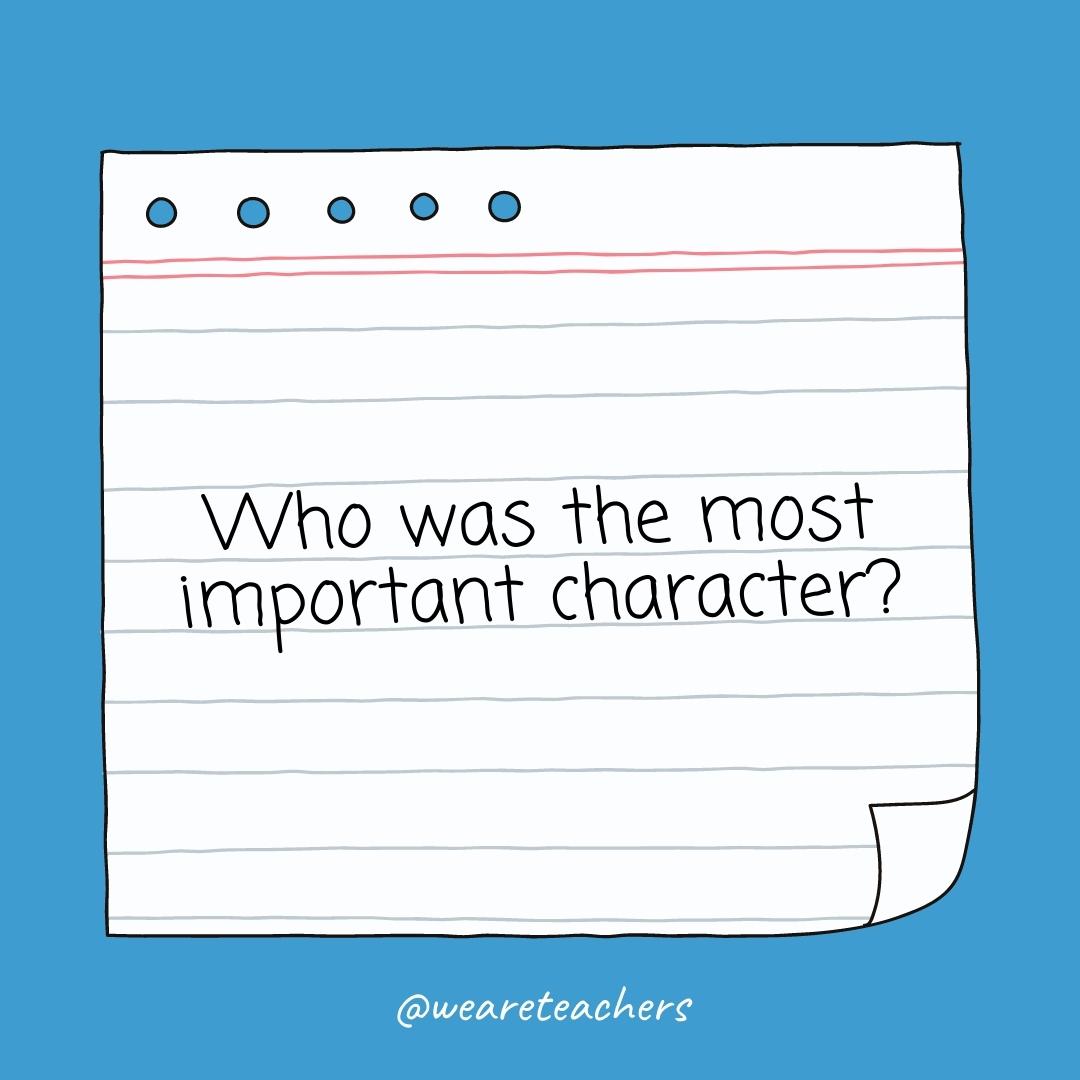
- Is responsible?
- Is most directly affected?
- Should have won?
- Will benefit?
- Would be affected by this?
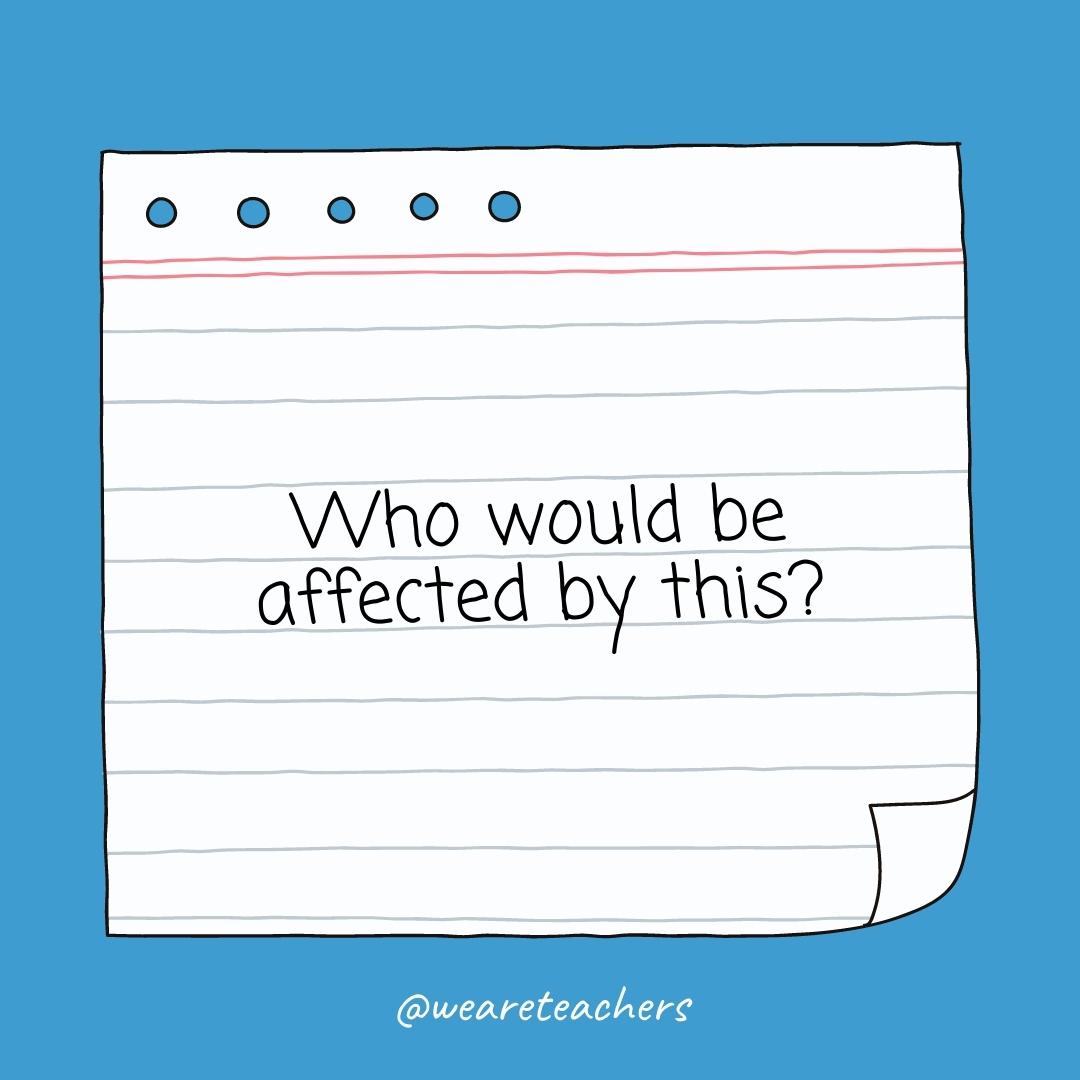
- Makes the decisions?
“What” Critical Thinking Questions
Ask questions that explore issues more deeply, including those that might not be directly answered in the text.
- Background information do I know or need to know?
- Is the main message?
- Are the defining characteristics?
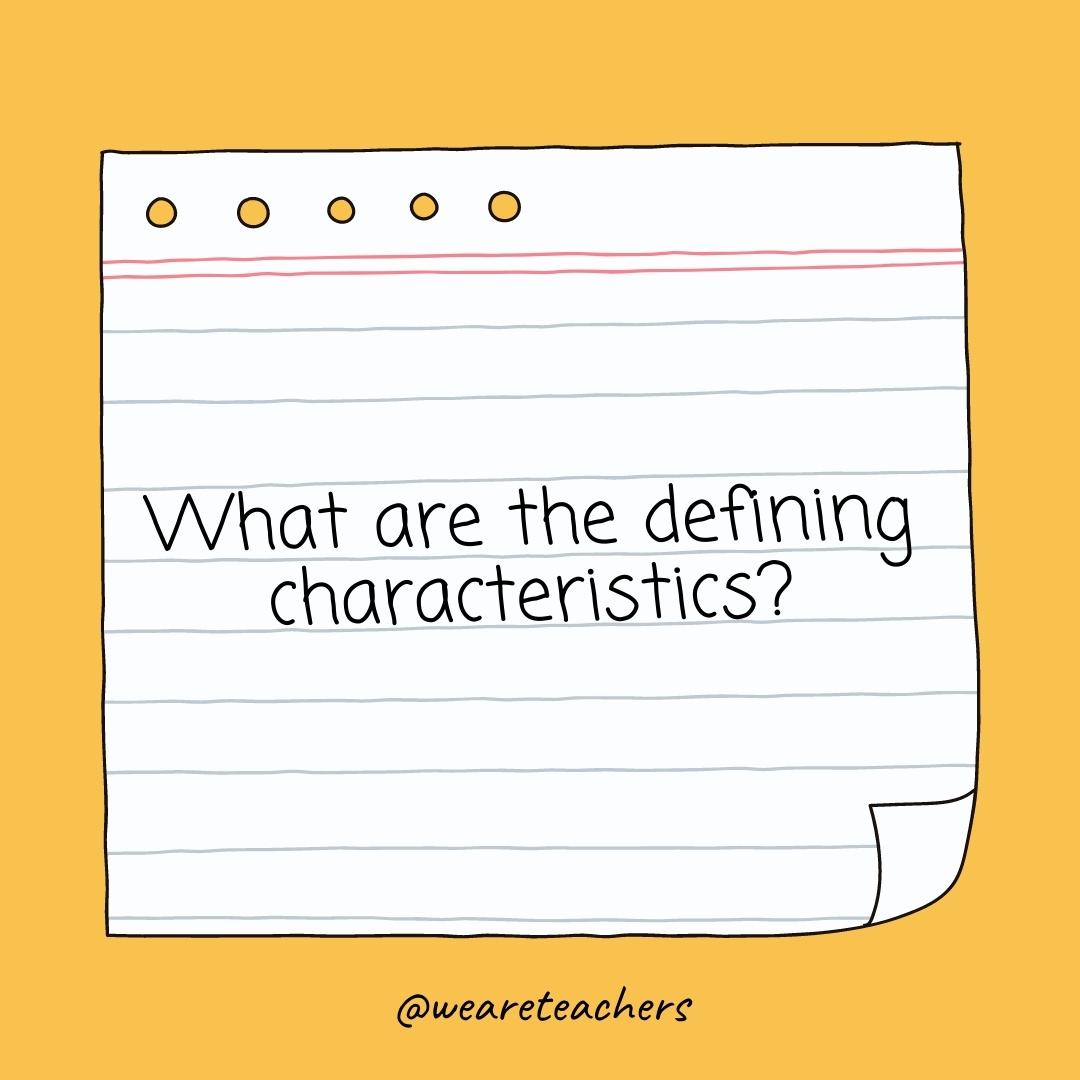
- Questions or concerns do I have?
- Don’t I understand?
- Evidence supports the author’s conclusion?
- Would it be like if … ?
- Could happen if … ?
- Other outcomes might have happened?
- Questions would you have asked?
- Would you ask the author about … ?
- Was the point of … ?
- Should have happened instead?
- Is that character’s motive?
- Else could have changed the whole story?
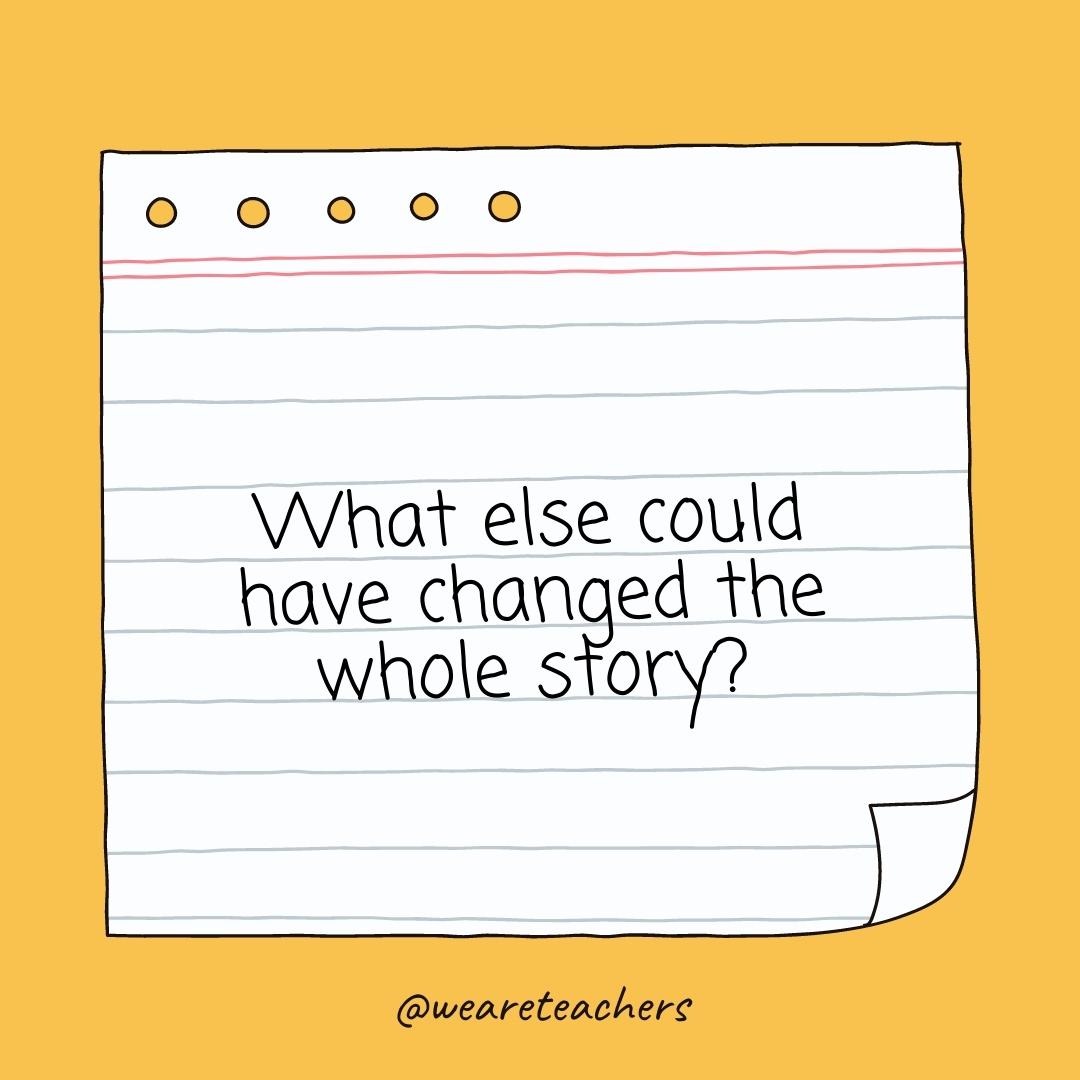
- Can you conclude?
- Would your position have been in that situation?
- Would happen if … ?
- Makes your position stronger?
- Was the turning point?
- Is the point of the question?
- Did it mean when … ?
- Is the other side of this argument?
- Was the purpose of … ?
- Does ______ mean?
- Is the problem you are trying to solve?
- Does the evidence say?
- Assumptions are you making?
- Is a better alternative?
- Are the strengths of the argument?
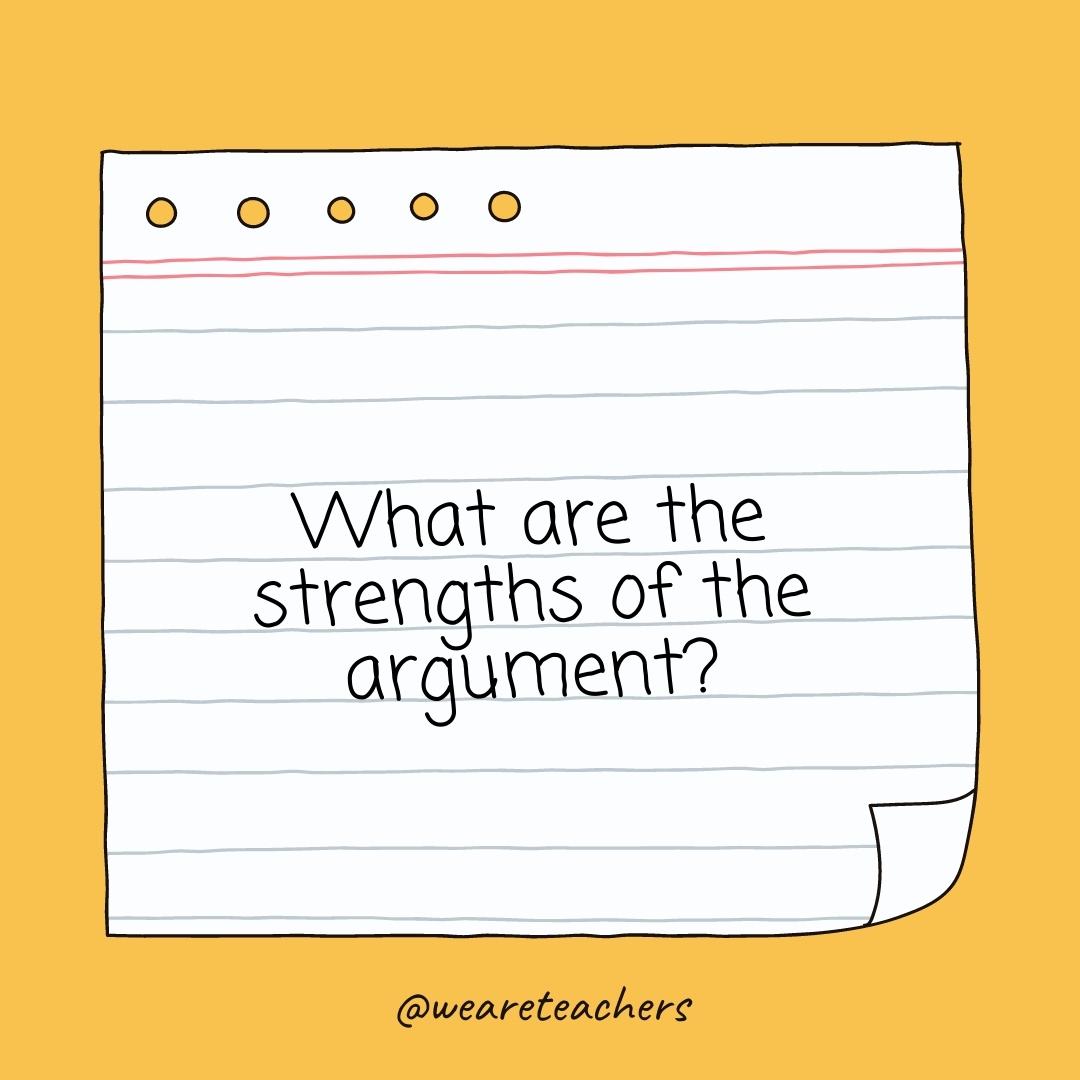
- Are the weaknesses of the argument?
- Is the difference between _______ and _______?
“Where” Critical Thinking Questions
Think about where the story is set and how it affects the actions. Plus, consider where and how you can learn more.
- Would this issue be a major problem?
- Are areas for improvement?
- Did the story change?
- Would you most often find this problem?

- Are there similar situations?
- Would you go to get answers to this problem?
- Can this be improved?
- Can you get more information?
- Will this idea take us?
“When” Critical Thinking Questions
Think about timing and the effect it has on the characters or people involved.
- Is this acceptable?
- Is this unacceptable?
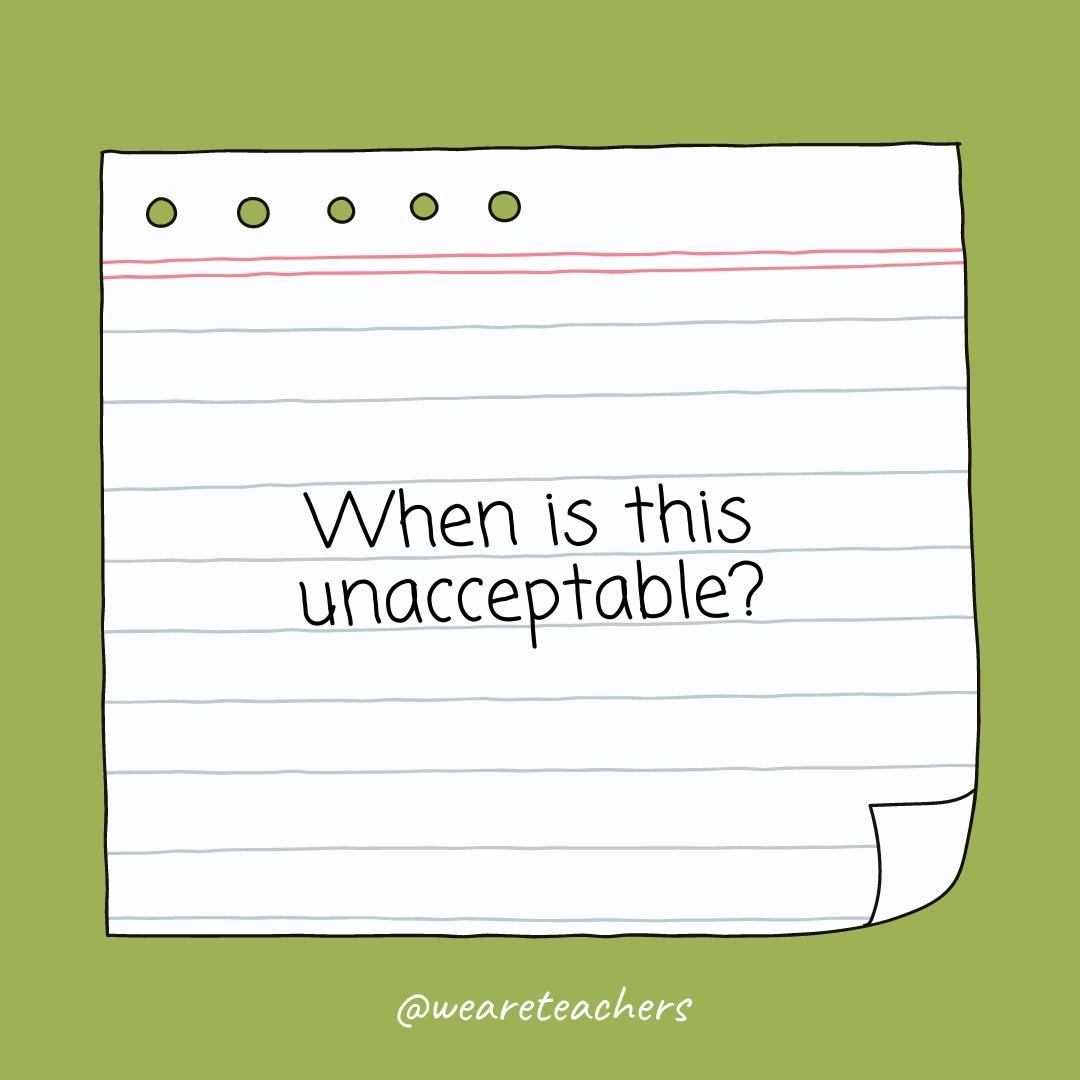
- Does this become a problem?
- Is the best time to take action?
- Will we be able to tell if it worked?
- Is it time to reassess?
- Should we ask for help?
- Is the best time to start?
- Is it time to stop?
- Would this benefit society?
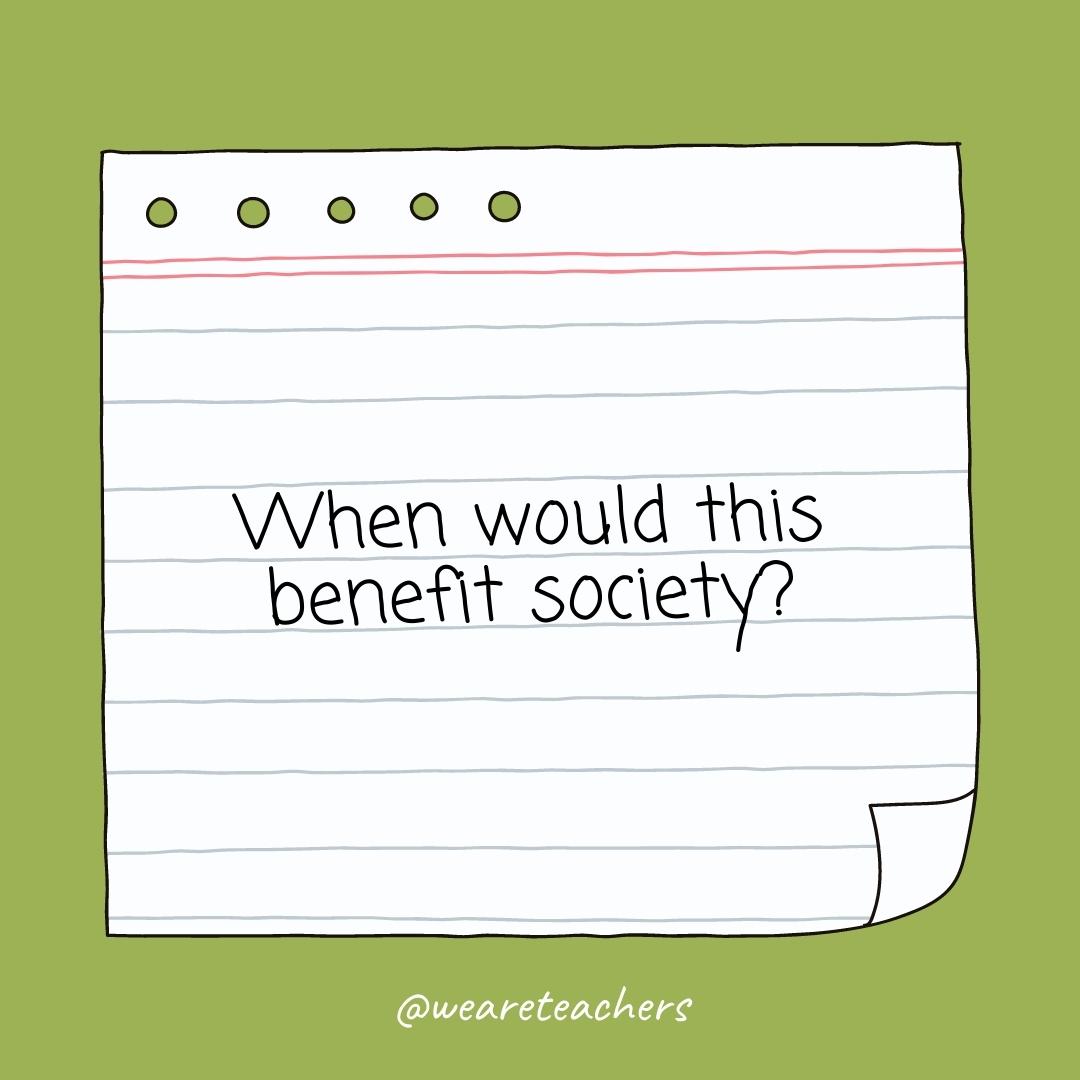
- Has this happened before?
“Why” Critical Thinking Questions
Asking “why” might be one of the most important parts of critical thinking. Exploring and understanding motivation helps develop empathy and make sense of difficult situations.
- Is _________ happening?
- Have we allowed this to happen?
- Should people care about this issue?
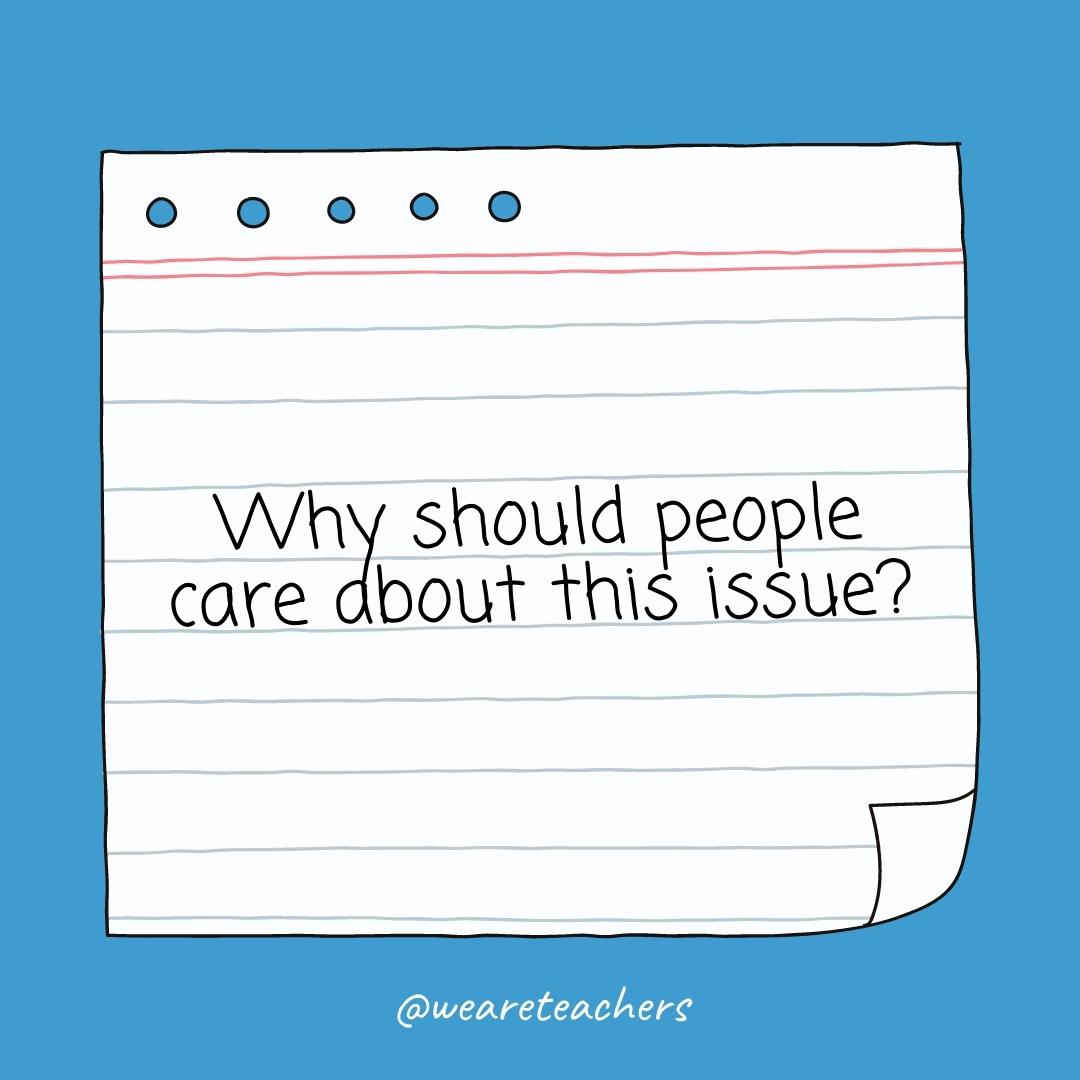
- Is this a problem?
- Did the character say … ?
- Did the character do … ?
- Is this relevant?
- Did the author write this?
- Did the author decide to … ?
- Is this important?
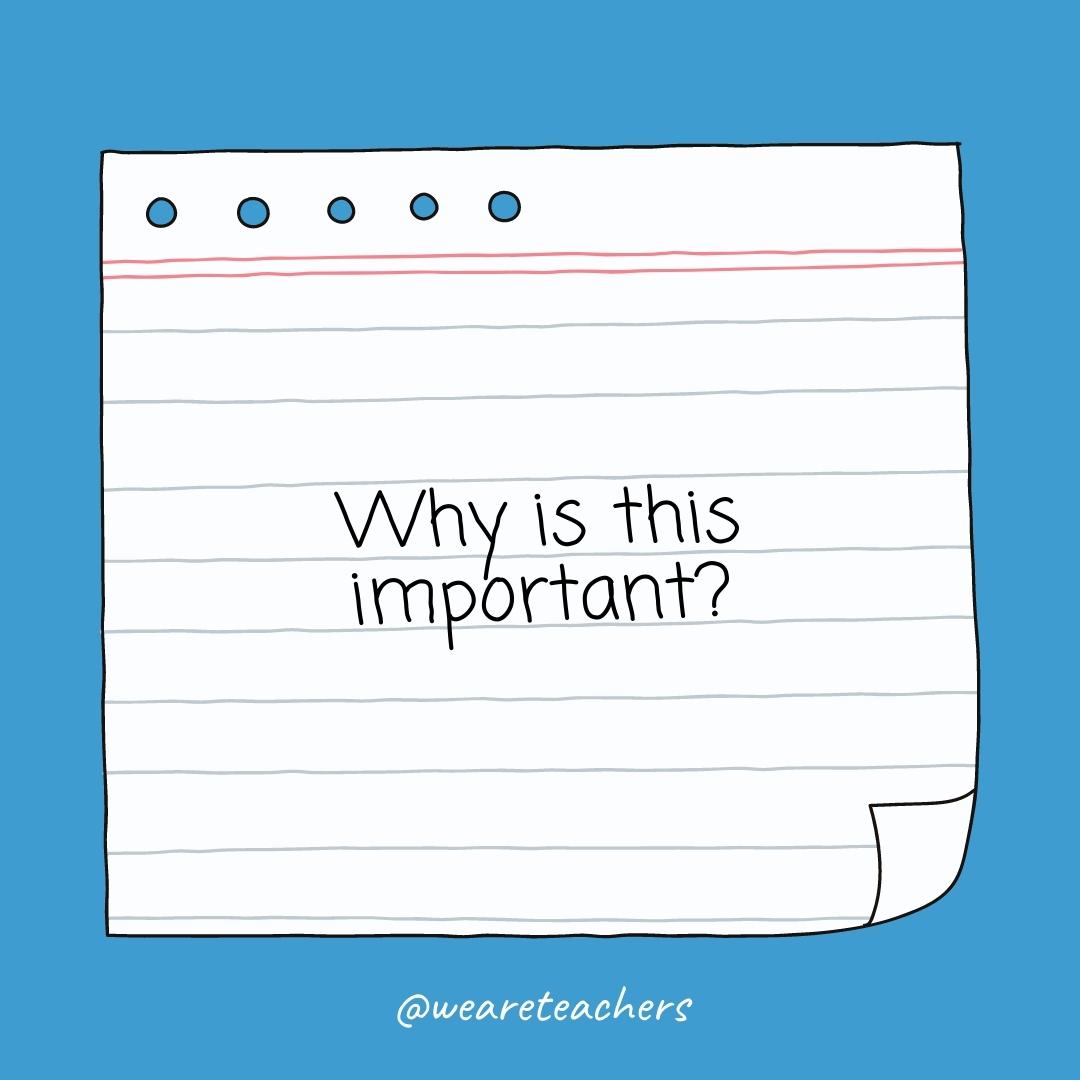
- Did that happen?
- Is it necessary?
- Do you think I (he, she, they) asked that question?
- Is that answer the best one?
- Do we need this today?
“How” Critical Thinking Questions
Use these questions to consider how things happen and whether change is possible.
- Do we know this is true?
- Does the language used affect the story?
- Would you solve … ?
- Is this different from other situations?
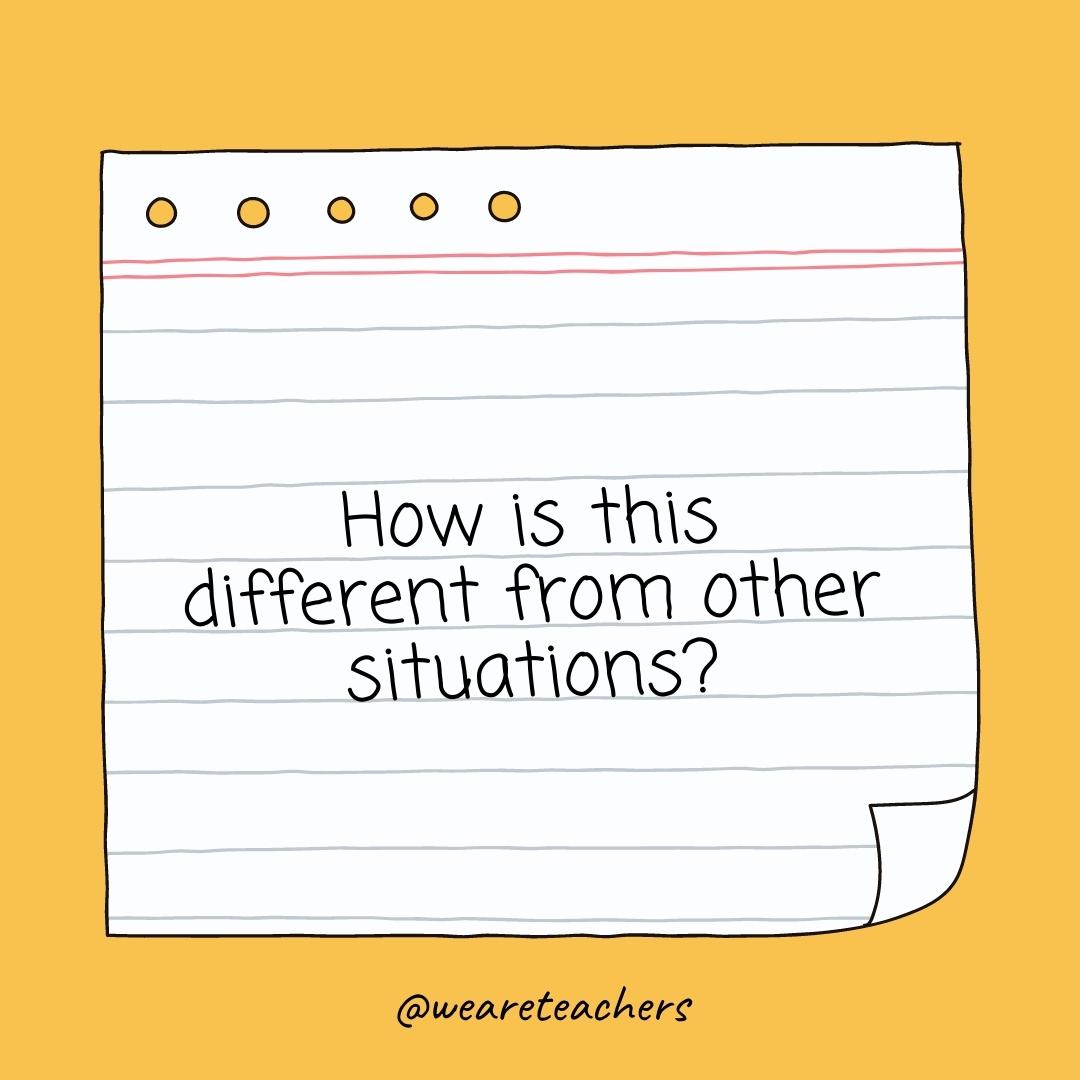
- Is this similar to … ?
- Would you use … ?
- Does the location affect the story?
- Could the story have ended differently?
- Does this work?
- Could this be harmful?
- Does this connect with what I already know?
- Else could this have been handled?
- Should they have responded?
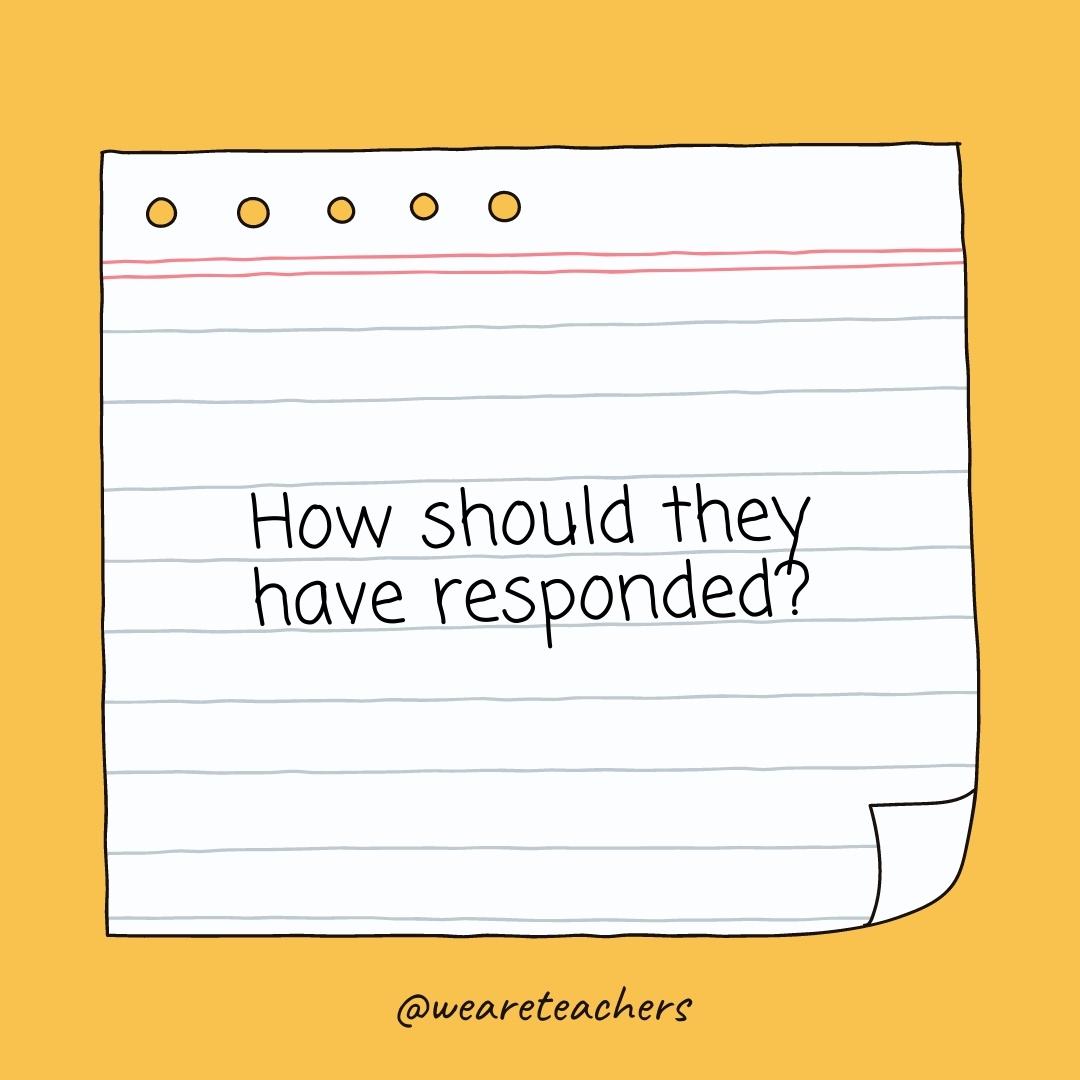
- Would you feel about … ?
- Does this change the outcome?
- Did you make that decision?
- Does this benefit you/others?
- Does this hurt you/others?
- Could this problem be avoided?
More Critical Thinking Questions
Here are more questions to help probe further and deepen understanding.
- Can you give me an example?
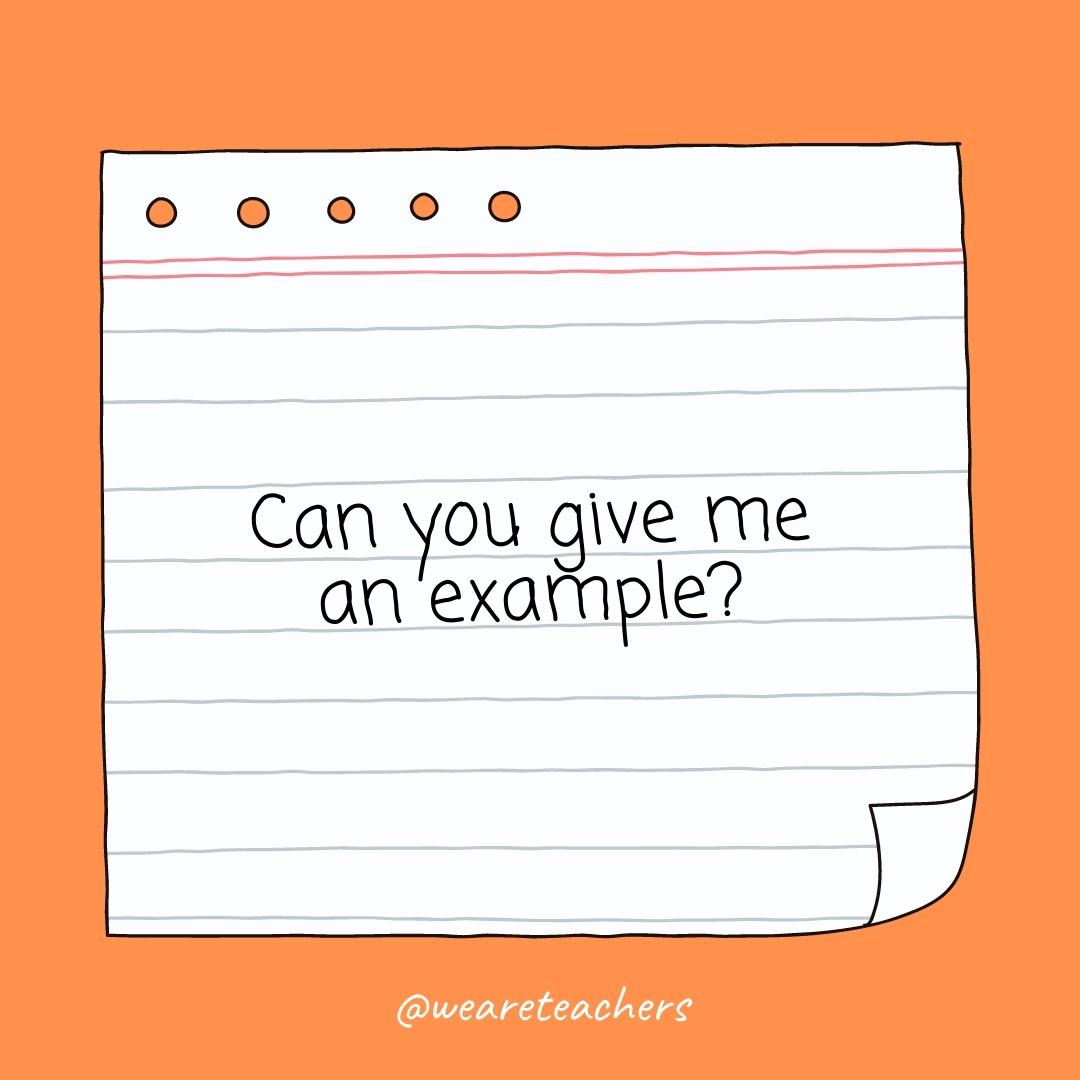
- Do you agree with … ?
- Can you compare this with … ?
- Can you defend the actions of … ?
- Could this be interpreted differently?
- Is the narrator reliable?
- Does it seem too good to be true?
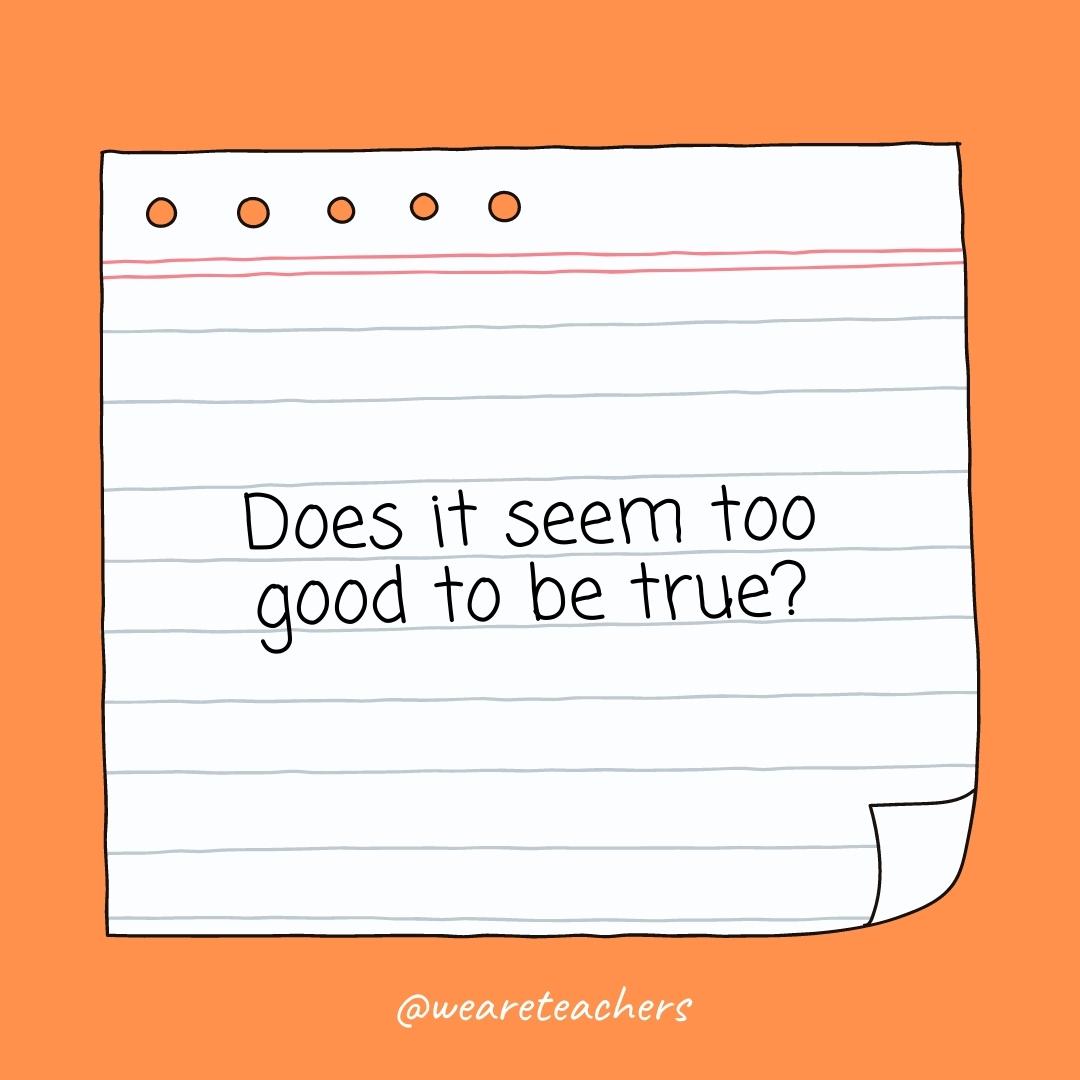
- Is ______ a fact or an opinion?
What are your favorite critical thinking questions? Come exchange ideas on the WeAreTeachers HELPLINE group on Facebook .
Plus, check out 10 tips for teaching kids to be awesome critical thinkers ., you might also like.

5 Critical Thinking Skills Every Kid Needs To Learn (And How To Teach Them)
Teach them to thoughtfully question the world around them. Continue Reading
Copyright © 2023. All rights reserved. 5335 Gate Parkway, Jacksonville, FL 32256
72 Physical Education Essential Questions

Description
Questions & answers, moving forward - 21st century physical education.
- We're hiring
- Help & FAQ
- Privacy policy
- Student privacy
- Terms of service
- Tell us what you think

Project-Based Learning Workshops
Inquiry Workshops
Differentiation Workshops
Objective Pluralism Workshops
Effective Online Teaching Workshops
SEL Workshops
PLC & Lesson Study Workshops
Growth Mindset Workshops
Assessment Workshops
AI in Education Workshops
Literacy Workshops
Admin/Leadership Workshops

Early Bird Registration Ends March 31st!

BLOG CATEGORIES
Differentiation
Growth Mindset
Tech Integration
Most Recent

Schedule a Call or Email Us!
Subscribe to our email newsletter.
19 Types of Questions To Grow Critical Thinking
Jan 25, 2021 | Inquiry

Fostering critical thinking skills is essential for individuals to navigate the complexities of the modern world. As educators, one powerful tool at our disposal is the art of questioning. Thought-provoking questions stimulate intellectual curiosity, challenge assumptions, and encourage deeper analysis. Here are 19 types of questions designed to cultivate critical thinking in the classroom, categorized for clarity and purpose.
Categories of Questions:
1. Exploratory Questions:
- Open-ended questions: Encourage students to explore ideas without restrictive boundaries. Example: “What are the possible outcomes of this situation?”
2. Analytical Questions:
- Socratic Questions: Prompt students to analyze their own thinking processes. Example: “How did you arrive at that conclusion?”
- Comparative Questions: Encourage students to examine similarities and differences between concepts. Example: “In what ways are these two theories alike or different?”
- Cause and Effect Questions: Prompt students to consider the consequences of actions or events. Example: “What might be the repercussions if this decision is implemented?”
3. Imaginative Questions:
- Hypothetical Questions: Challenge students to think beyond the present and consider imaginary scenarios. Example: “What would happen if we reversed the roles in this situation?”
- Problem-Solving Questions: Engage students in critical thinking by presenting real-world problems. Example: “How would you address the challenges faced by the characters in this case study?”
4. Ethical Questions:
- Ethical Dilemma Questions: Foster moral reasoning by presenting ethical quandaries. Example: “If you had to choose between honesty and loyalty, which would you prioritize and why?”
5. Inference and Reflection Questions:
- Inference Questions: Encourage students to draw conclusions based on available information. Example: “What can you infer from the data provided?”
- Reflection Questions: Stimulate metacognition by prompting students to reflect on their own thought processes. Example: “How has your perspective on this topic evolved over time?”
6. Divergent Thinking Questions:
- Contradiction Questions: Encourage students to identify and resolve conflicting ideas. Example: “How can we reconcile these two seemingly contradictory viewpoints?”
- Prioritization Questions: Challenge students to determine the most significant factors in a given situation. Example: “What factors should be prioritized in making this decision?”
7. Integrative Questions:
- Interdisciplinary Questions: Encourage the integration of knowledge from multiple disciplines. Example: “How might principles from psychology and economics intersect in this context?”
8. Forward-Thinking Questions:
- Predictive Questions: Prompt students to anticipate future developments based on current trends. Example: “What might be the long-term implications of this social phenomenon?”
9. Collaborative and Metacognitive Questions:
- Collaborative Questions: Foster teamwork and collective problem-solving. Example: “How can diverse perspectives contribute to a more comprehensive understanding of this issue?”
- Meta-Questions: Encourage students to think about their thinking. Example: “What assumptions underlie your perspective, and how might they influence your conclusions?”
10. Awareness Questions:
- Bias Recognition Questions: Develop awareness of personal biases and perspectives. Example: “In what ways might your background influence your interpretation of this information?”
11. Systems Thinking Questions:
- Systemic Thinking Questions: Prompt students to consider the broader systems at play. Example: “How does this individual decision impact the larger system?”
12. Relevance and Adaptation Questions:
- Relevance Questions: Challenge students to assess the significance of information. Example: “How does this information contribute to our understanding of the main issue?”
- Adaptation Questions: Encourage flexibility in thinking by exploring alternative solutions. Example: “If the circumstances change, how might your approach to this problem evolve?”
Incorporating these diverse question types into your teaching repertoire can transform the learning experience, help create a culture of inquiry , equipping students with the invaluable skill of critical thinking. As educators, we have the power to shape not only what our students know but also how they think, empowering them to navigate the complexities of an ever-changing world with confidence and intellectual agility.

Early-Bird Registration is open!

ThoughtStretchers Education

We'll be launching our ThoughtStretchers Community very soon!
Join our email list and you'll receive updates about the launch and events and more as we grow.
*note, this is different from our main ThoughtStretchers Education email list which is focused on our professional development work.
You have Successfully Subscribed!

85 Critical Thinking Questions to Carefully Examine Any Information
There might be affiliate links on this page, which means we get a small commission of anything you buy. As an Amazon Associate we earn from qualifying purchases. Please do your own research before making any online purchase.
The ability to think critically will often determine your success in life.
Let’s face it. Every day, we are bombarded by news, social media updates, and an avalanche of information. If you take all of this at face value, it’s easy to be deceived, misled or ripped off.
That’s why it’s important to develop a mindset that focuses on critical thinking . This is a skill that needs to be developed in the classroom. But it’s also a valuable life skill.
With that in mind, the following post will share 85 critical thinking questions you can use to increase your awareness about different problems by carefully examining available information.
Let’s get started…
Table of Contents
What Are Critical Thinking Questions?
Critical thinking questions are inquiries that help you think rationally and clearly by understanding the link between different facts or ideas. These questions create a seemingly endless learning process that lets you critique, evaluate, and develop a depth of knowledge about a given subject. Moreover, you get to reinforce your viewpoints or see things in a new way.
We make decisions every day, whether at work or home. Adopting logical, rational, and practical approaches in addressing various issues requiring critical thinking is essential in decision-making. Therefore, before arriving at a decision, always ask yourself relevant questions and carefully analyze the matter’s pros and cons.
Critical Thinking Questions When in an Argument
When you make an argument using a critical thinking approach, you focus on justified claims that are valid and based on evidence. It helps one establish a strong argument.
- Do I disagree with the other person? Might the person I'm arguing with be misinformed on what they are saying?
- Would I be comfortable saying what I am telling him/her if I was in front of a group of people?
- What would happen if I lose this argument? Is engaging in this argument worth my time and energy? How will I feel if I lose?
- Is there room for ambiguity or misinterpretation? Are we arguing because I didn't make my point explicit? Should I take my time to understand his school of thought?
- Do I need some rest before saying something? Am I arguing because of other reasons other than the issues at hand? Do I need to take some time and cool down?

- Is it more important that I’m right? Am I trying to ask to prove an unnecessary point?
- Is this argument inductive, deductive, or abductive? Is it a weak or strong argument that I need to engage in? Is it compelling or sound?
- Is my opponent sincere? Given that they are wrong, are they willing to admit that they are wrong? Can they depend on available evidence, wherever it leads?
- Are my opponents only trying to shift their burden to me? What is the best way to prove them wrong without making them feel bad?
- Are the people I'm arguing with only interested in winning, or are they trying to pass some information across and help me discover the truth?
Critical Thinking Questions When Reading a Book
When you read a book, you probably ask yourself many “why” questions. Why is this a problem? Why did the character say that? Why is this important? The most challenging part of reading a book is assessing the information you are reading. These questions can help.
- If I learn only two things from this book, what will they be? How will they help me? How will I apply them in my daily life?
- What message are the authors trying to pass across? Are they making suggestions or providing evidence for their arguments?
- Given that almost every book is about solving problems, what is the most prevalent issue that the author is trying to solve?
- What is the author’s writing style? What strategy or master plan does the author employ to convey his/her main ideas throughout the book?
- Do I have background information about the book’s topic? If so, how is what the author is saying different from what I already know?
- What didn’t I understand from the book? Should I re-read the book to understand everything the writer is trying to convey?
- Which sections of the book do I love the most, and why? Generally, do I like this book? Should I look for more books that are written by the same author?
- If I had a chance to meet this book’s author, what questions would I ask him/her? What would I tell the writer about the book? Is it a great book worth recommending to your friends and family members?
- Who are the main characters of the book? If there is only one main character, what overarching goal does the character accomplish?
- In what ways did the protagonist change from the start of the book to the end? What caused the changes? Was the protagonist reckless in some ways? Which ways?
Critical Thinking Questions to Spot a Scam
Asking questions when you feel that a fraud or a scam is being presented to you is a good way to stretch your critical thinking muscles. Are you being emailed or messaged by a stranger? Or maybe there are other red flags you are unsure about. If so, ask these questions.
- Does it seem to be too good to be true? Is this stranger pushy or trying to lure me into making a poor decision?
- When trying out online dating: Is my new “friend” professing strong feelings towards me although we’ve only interacted for a few hours?
- Why is a stranger calling me to ask about my Social Security Number (SSN), personal contact information, or bank details while claiming they are from the bank or a phone company?
- When buying products online, why does the seller ask me to pay for goods using an insecure payment option like Bitcoin or money order?
- Does the email I have received have any spelling or grammatical errors? Is the language used overly formal or informal?
- If I do a quick search about the exact words of the email I received, does Google indicate it's a fraud or scam?
- Why should a stranger manipulate me using obvious questions like “Would you want to be rich or poor?” While they already know the answer?
- Is the email asking me to download an attachment? Or click a link to some insecure website?
- Is the person trying to make me feel selfish or guilty for not sending them money, whether for a donation or buying a product?
- Is the stranger portraying a sense of urgency and using pressure tactics? Are they telling me that their family member needs urgent medical attention?
Critical Thinking Questions About Your Life
It can also help to ask yourself a few critical thinking questions about your life. This way, you can gather basic information and uncover solutions to problems you might not have otherwise thought of.
- Where do I wish to be in a few years, probably two, three, or five years? What short-term and long-term goals should I set?
- What have I achieved so far from the time I set my previous goals? What should I be grateful for?
- Do I have any values that guide me in life? If so, what are these values? Am I always true to these values?
- Am I always worried about what people around me think? Can I act independently without the need to meet social expectations?
- What should people say about me at my funeral? Would they talk about how good I made them feel or how rich and flashy I was?
- If I wasn't afraid of anyone or anything, what would I have done? What if I didn't have any fear in me?
- If today was my last day, what extraordinary thing would I do? Can I do it right now?
- What should I do with the things that matter the most to me?
- What things will make the greatest difference in my future life if I take action now?
- How should I react when I feel unwanted by the people I love the most? Should I tell them?

Critical Thinking Questions for a Debate or Discussion
When you are in the middle of a debate or discussion, you need to know that what you are saying is fact, have evidence to support your claim, and position yourself as an expert in what you are saying. Here are some critical thinking questions to ask when you are in a debate or discussion.
- Is there fairness in this discussion? Is the moderator supporting one side? Do they want to make one side look stupid or wrong?
- What is the aim of this discussion? Is there a major problem that needs to be solved? If so, how can I help solve it?
- Who are the people affected by this discussion? If they were here, what would they say?
- Do my views on this discussion matter? If I raise my point, will I be redundant?
- What am I supposed to learn from this debate, and how can I use what I have learned in my daily life?
- Does the audience seem to be biased towards one side? Are they booing one side? What can I do even if it's our opponents being booed?
- Who are the discussion panel members? What views have they held about this kind of discussion or any other related discussions in the past?
- How can I make my point without being ambiguous? Before I speak, should I take down some notes to avoid any confusion during my speech?
- Am I ready to apologize if I make a mistake during the discussion? If so, what are the limits?
- What information does my team, or I need before this discussion?
Critical Thinking Questions About Lying
Admitting when you are wrong, choosing not to cheat, and sharing constructive feedback are all ways to show your honesty. Here are some critical thinking skills to ask regarding lying.
- Will the lie hurt those I am telling, or will it help them? What if being honest might cause my friend unnecessary pain?
- Should I be the one telling this person a lie, or I let someone else do it?
- Will I be the one hurt if I tell this lie? Will my friend feel I am a betrayer? Will it affect our friendship?
- Do they answer my questions in detail, or are they always trying to ignore and dodge the main problem?
- What if I ask these people the same question using different terms and wording? Will they give me the same response?
- Did the tone of my friend suddenly change after I asked him/her this question? Do they sound louder, faster, or slower compared to how they usually speak?
- Does this person have something to gain by lying to me? What is their motive?
- Does this person take a sudden pause or hesitate more than usual when responding to my question?
- When I look at these people's faces, do their facial expressions match what they say?
- Should I believe this person or not? What are my intuitions? Does it look like they are telling the truth?
- Do they blink like other days when I ask them questions? Are they always trying to avoid direct eye contact?
- Why do they seem uncomfortable when it’s just a normal conversation?
Critical Thinking Questions When Presented With a Claim
Critical thinking is much more than just evaluating whether a claim is true or not. It also means a critical thinker reflects on what follows from true claims.
- What does this claim mean, and what are its implications? What if it's a false claim?
- Which of my morals, values, or beliefs do I have to give up to accept this claim?
- Do professionals in this field agree or disagree with the claim that has been made?
- Do they have evidence to back their claim? Which is the most robust evidence to support the claim?
- What argument can I come up with to refute this claim? Or what is the best view that can support this claim?
- Who is the primary source of the claim being made? Is the basis of the claim reliable?
- Is it a claim, or it's just an opinion?
- Is the claim likely to be 100% false, true, or partially true?
- Am I allowed to refute the claim and table my evidence, or is it one-sided?
Critical Thinking Interview Questions
Critical thinking skills are valuable in any industry or field and for almost all roles. During a job interview, you will be asked questions so the potential employer can assess your skills and see how you use logic. Your critical thinking ability is just one vital part that can play into your professional development.
- Is there a time you had to convince someone to use an alternate approach to solve a problem?
- Have you ever had to make a difficult decision quickly?
- How would you handle a situation where your supervisor handled something wrong or made a mistake?
- What is one of the most difficult decisions you have ever had to make at work?
- How would you solve a disagreement between coworkers when approaching a project?
- Can you describe a time when you anticipated a problem ahead of time and took the appropriate steps to stop the problem from becoming an issue?
- If you discover a cheaper way to do something or a better solution to a problem and try to explain it to your supervisor, but they don’t understand, what do you do?
Critical Thinking Questions for Kids
We can’t leave the kids out either. Critical thinking questions for kids get them thinking and talking. It also allows a parent to get to know their child better.
- How many grains of sand do you think are on the beach?
- What would happen if it stopped raining?
- Do you think there is life on other planets?
- Should children be able to set their own bedtimes?
- How would you describe what a tree looks like without saying green or leaves?
- Can you name five different emotions?
- Can you talk for five minutes without uttering “um?”
What Are the Basic Principles of Critical Thinking?
Your critical thinking skills involve gathering complete information, understanding and defining terms, questioning the methods by which we get facts, questioning the conclusions, and looking for hidden assumptions and biases.
Additionally, we can’t expect to find all of the answers, and we need to take the time to examine the big picture of it all.
Here are the basic principles:
- Disposition: Someone with critical thinking skills is often skeptical, open-minded, and practices fair-mindedness. They can look at different viewpoints and change positions if the evidence and reason lead them to do so.
- Criteria: In order to think critically, one must also apply criteria. Certain conditions must be met before someone believes in something. The information needs to be from credible sources.
- Argument: An argument is simply a statement or proposition that is shown with supporting evidence. When you use your critical thinking skills, you identify, evaluate, and construct your argument.
- Reasoning: With critical thinking comes reasoning. You must examine logical relationships among the statements being made.
- Point of View: Critical thinkers can see things from different perspectives and different points of view.
What Are Good Analysis Questions?
Analysis is a part of critical thinking that allows you to examine something carefully. Someone with analytical skills can examine the information presented, understand what that information means, and then properly explain that information to others. Analysis in critical thinking provides more clarity on the information you process.
When analyzing, you may ask yourself, “how do I know this,” how would I solve this problem,” and “why does it matter?”
Why Is Critical Thinking an Important Skill?
Critical thinking skills allow you to express thoughts, ideas, and beliefs in a better way. It also leads to improved communication while allowing others to understand you better. Critical thinking fosters creativity and encourages out-of-the-box thinking. This is a skill that can be applied to many different areas of your life.
For example, knowing the answers to critical thinking questions for a job interview will better prepare you for the interview. Many employers, during questioning, are likely to ask you critical thinking questions to assess if you have the ability to evaluate information effectively so you can make more informed decisions.
Final Thoughts on Critical Thinking Questions
Although it's common to get torn between making two or more choices, nobody wants to make the wrong decision. The only thing you can do to avoid this is use critical thinking questions to examine your situation. The answers to these questions will help you make informed decisions and help you comprehend crucial matters in your life.
Want to learn more about critical thinking and decision-making using a real-life example? Here is how Jeff Bezos uses critical thinking to make some of the most challenging life decisions.
Finally, if you want to ask better questions, then watch this short, 20-minute course to learn how to have a great conversation with virtually anyone .
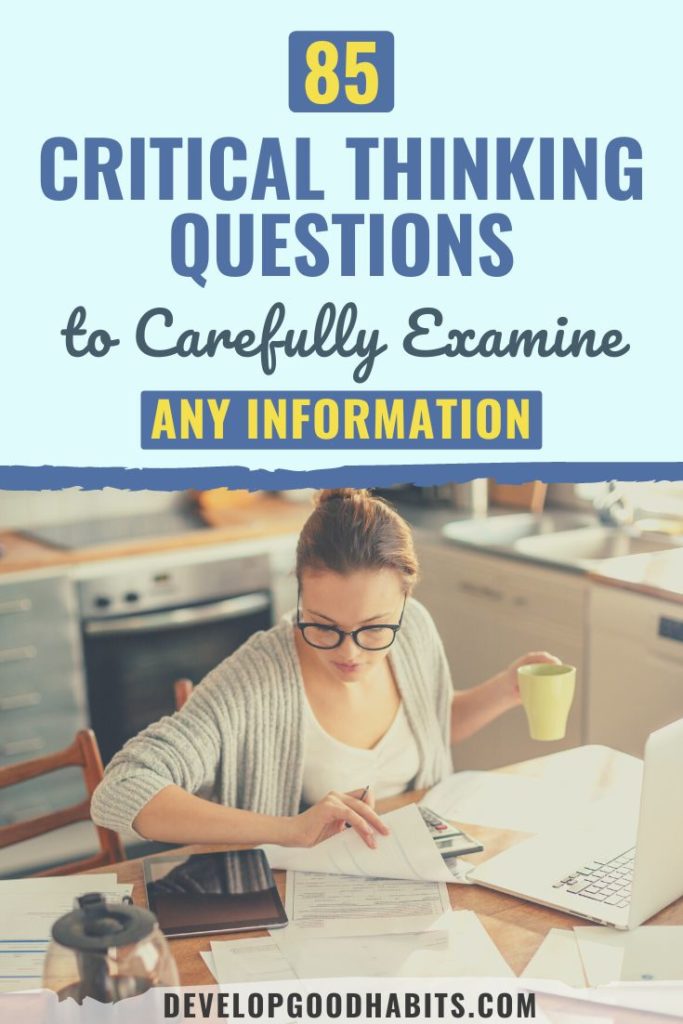
Critical thinking definition

Critical thinking, as described by Oxford Languages, is the objective analysis and evaluation of an issue in order to form a judgement.
Active and skillful approach, evaluation, assessment, synthesis, and/or evaluation of information obtained from, or made by, observation, knowledge, reflection, acumen or conversation, as a guide to belief and action, requires the critical thinking process, which is why it's often used in education and academics.
Some even may view it as a backbone of modern thought.
However, it's a skill, and skills must be trained and encouraged to be used at its full potential.
People turn up to various approaches in improving their critical thinking, like:
- Developing technical and problem-solving skills
- Engaging in more active listening
- Actively questioning their assumptions and beliefs
- Seeking out more diversity of thought
- Opening up their curiosity in an intellectual way etc.
Is critical thinking useful in writing?
Critical thinking can help in planning your paper and making it more concise, but it's not obvious at first. We carefully pinpointed some the questions you should ask yourself when boosting critical thinking in writing:
- What information should be included?
- Which information resources should the author look to?
- What degree of technical knowledge should the report assume its audience has?
- What is the most effective way to show information?
- How should the report be organized?
- How should it be designed?
- What tone and level of language difficulty should the document have?
Usage of critical thinking comes down not only to the outline of your paper, it also begs the question: How can we use critical thinking solving problems in our writing's topic?
Let's say, you have a Powerpoint on how critical thinking can reduce poverty in the United States. You'll primarily have to define critical thinking for the viewers, as well as use a lot of critical thinking questions and synonyms to get them to be familiar with your methods and start the thinking process behind it.
Are there any services that can help me use more critical thinking?
We understand that it's difficult to learn how to use critical thinking more effectively in just one article, but our service is here to help.
We are a team specializing in writing essays and other assignments for college students and all other types of customers who need a helping hand in its making. We cover a great range of topics, offer perfect quality work, always deliver on time and aim to leave our customers completely satisfied with what they ordered.
The ordering process is fully online, and it goes as follows:
- Select the topic and the deadline of your essay.
- Provide us with any details, requirements, statements that should be emphasized or particular parts of the essay writing process you struggle with.
- Leave the email address, where your completed order will be sent to.
- Select your prefered payment type, sit back and relax!
With lots of experience on the market, professionally degreed essay writers , online 24/7 customer support and incredibly low prices, you won't find a service offering a better deal than ours.

Five tough questions in the wake of the Baltimore Key Bridge collapse
A s the full scope of the dramatic and shocking collapse of Baltimore's crucial Francis Scott Key Bridge comes into focus, the region and the nation are just beginning to grapple with what the future, both near and long-term, might hold, but there are tough questions still unanswered.
The bridge was a critical link in the transportation system serving a metro area of more than 2.8 million people and a vital artery for East Coast shipping. Its collapse not only means the loss of a major roadway but also at least temporarily a large, thriving port until the wreckage of the bridge and the ship can be cleared and, perhaps, a new bridge can be constructed.
Here are some of the unknowns and some questions without easy answers.
Start the day smarter. Get all the news you need in your inbox each morning.
Why did a cargo ship ram the Francis Scott Key Bridge?
The cause of the collapse was evident in gut-wrenching video that captured the moments Tuesday when the Dali , a hulking , Sri Lanka-bound cargo ship, hit one of the bridge's A-shaped support piers, causing the steel structure to fail and fall into the Patapsco River.
Officials say the 984-foot ship suffered a power outage and sounded a mayday, allowing them to stop vehicle traffic before the collision. But they have not yet elaborated on why the ship lost power or other factors that may have played a role. The National Transportation Safety Board recovered the vessel's black box recorder and the investigation is ongoing.
What happened, in depth: A giant ship. A power blackout. A scramble to stop traffic: How Baltimore bridge collapsed
How long will it take to remove the ship and the debris in the water?
Benjamin Schafer, a professor of civil and systems engineering at Johns Hopkins University, said Wednesday that it would be difficult to gauge how long it might take to remove debris from the Dali and the bridge.
But in a meeting with journalists, he indicated it would be wise to think in terms of months, rather than weeks.
“I’d be shocked if it’s weeks but I don’t think it’ll take even a year,” said Schafer, a structural engineer.
The latest news: Baltimore bridge recovery effort presses on; 22-member crew still aboard ship
How long will it take to rebuild the bridge in Baltimore?
A complete rebuild could take a decade or more, Schafer said. He noted that building the original bridge took five years and rebuilding the Skyway Bridge in Tampa after it was hit by a freighter in 1980 took seven.
“To actually recreate that whole transportation network," he said. "Projects that large take “rarely less than 10 years."
Visualizing the collision and collapse: After ship hits Baltimore bridge, mapping how the collapse unfolded
How much will all of this cost?
Addressing the crisis from the White House, President Joe Biden on Tuesday pledged federal support for the rebuilding process.
“It's my intention that federal government will pay for the entire cost of reconstructing that bridge. And I expect the Congress to support my effort,” Biden said. "It's going to take some time. The people of Baltimore can count on us, though, to stick with them at every step of the way until the port is reopened and the bridge is rebuilt."
Who will pay for it? With death toll unknown and bridge collapsed, Biden pledges federal support for Baltimore
That tab could be exceptionally high, Schafer said . Removing the Dali and the bridge debris and rebuilding the bridge and surrounding infrastructure would be an enormous undertaking at today's rates.
"The price tags never seem to be out of the hundred of millions these days," he said.
How can disasters like the collapse of the Baltimore bridge be prevented?
Susu Xu, an assistant professor at Johns Hopkins' Department of Civil and Systems Engineering, said there are some s teps that can be taken to try and avert a bridge collapse and potentially catastrophic loss of life.
Aging infrastructure: Baltimore bridge collapse reignites calls for fixes to America's aging bridges
Sensors could be installed on piers or bridge decks to detect when a ship is getting too close and trigger warning lights to stop traffic from entering the bridge and alert emergency responders and other agencies, Xu said.
Building collapse-proof bridges is more challenging, Schafer said. It could be done, but it would be costly. So-called dolphin structures – barriers placed near bridges to divert ships – can be helpful, he said, but they might not work, given the sheer volume of cargo vessels.
"These things are a balance and we as a society, we have to try to make these choices the best we can to have the economic engines like the port, to have a transportation network," Schafer said. "What it feels like right now is that we didn't get the balance right, and there needed to be more consideration for this possible event."
This article originally appeared on USA TODAY: Five tough questions in the wake of the Baltimore Key Bridge collapse


IMAGES
VIDEO
COMMENTS
When asking such questions, Muijs and Reynolds (2011), suggests giving pupils at least 3 seconds thinking time for convergent/closed questions , and 15 seconds for divergent/open questions.One simple strategy to help engage pupils in questioning is 'Think, Pair, Share' - the teacher poses the question and gives pupils thinking time.Students then share their answers with a partner.
These forms of thinking skills have been associated with a number of 'Critical thinking' learner dispositions including; open and fair mindedness, flexibility of thought, inquisitiveness and willingness to take risks (Lai, 2011). Within the PE literature, critical thinking is a term first popularised by McBride (1992).
It sparks critical thinking and fosters a passion for staying active. Thoughtful questioning and strategies can transform how our students learn in PE and view it as a subject.
Critical thinking covers many aspects of thought including planning, reasoning, logic and reflection. Physical education class, or P.E., can incorporate all the aspects of critical thinking in many activities. It is the job of the teacher to make students think about the lessons they are being taught to utilize ...
Question matrix for the design of essential or guiding questions in PE . ... Fostering critical thinking in physical education. Journal of Physical Education, Recreation & Dance, 80 (8), 12-18.
Critical thinking includes examining, questioning, evaluating, and challenging taken-for-granted assumptions about issues and practices. Critical action is action based on critical thinking. By adopting this definition of critical thinking and applying it to their learning in education contexts, ākonga can: become broad and adventurous thinkers.
Critical and creative thinking skills are developed in PE through learning environments that encourage experiences that direct students to answer questions posed by the teacher and,
Abstract. Critical thinking is essentially "better thinking.". When students think critically they consider complex information from numerous sources and perspectives in order to make a ...
Defines critical thinking and provides a practical approach to applying it to teaching physical education (PE). Critical thinking in PE can result in improved skills, fitness, and knowledge. Examples of the kinds of questions and challenges appropriate for a critical thinking lesson in PE are provided. (SM)
McBride be seen as a contradiction in terms. Initial research has and Bonnette (1995) found a significant increase in the crit- shown, however, that the physical education setting is ide- ical thinking scores of a group of at-risk boys after they had ally suited for fostering critical thinking (McBride 1989, participated in activities requiring ...
Covering self-contained adapted physical education classes, general physical education programs, and youth sports and community recreation, this book presents a series of case studies of teaching individuals of varied ability and disability in physical activity settings. Outlining realistic scenarios, it encourages an interactive, problem-solving teaching and learning style and the development ...
Through a contemporary dance approach, the author supports students' creativity and leads them to express their understanding of the unit 'Sharing the planet' in a meaningful way. In physical education (PE) class, we have been using a number of thinking routines to increase engagement and deepen the student's understanding of a unit of ...
Here are some strategies to promote higher-order thinking in physical education: Inquiry-based learning. Problem-solving challenges and case studies. Reflective journals. Debates and discussions ...
The broad aim of critical pedagogy, as it relates to physical education, is to critique the socially constructed nature of human health, physicality, and movement culture and take action to ensure it is socially just, equitable, and inclusive. Human movement culture is full of possibilities for enriching people's lives.
The Cornell Critical Thinking Test (CCTT) is one of the many multiple-choice tests with validated questions that have been reported to measure general critical thinking (CT) ability. Level X is a 71-item, multiple-choice test for students in grades 5-12 + (Ennis et al., 2005 ; Leach et al., 2020 ).
The PE Thinking Games section provides you with Physical Education resources which will help you to plan PE Thinking Strategy Games. Each PE Game outlines what equipment is required, how to set the game up, how to play the game and how to differentiate the game.
1) Critical thinking must be a kind of skill that can be learned. 2) Critical thinking is a kind of mind habit or a knowledgeable quality, which is used willingly and the effects of these reasoning skills is accepted. Thus, CT is a set of knowledge able qualities that noble thinkers possessed it.
In an age of "fake news" claims and constant argument about pretty much any issue, critical thinking skills are key. Teach your students that it's vital to ask questions about everything, but that it's also important to ask the right sorts of questions. Students can use these critical thinking questions with fiction or nonfiction texts.
21st Century Physical Education 72 - Physical Education Essential Questions designed to help assess comprehension of fundamental knowledge, essential concepts, and big ideas in the world of physical education. These questions can be easily altered to be made simpler or more challenging. Many of the questions can be modified to fit numerous lessons and instructional units.
The Ultimate Cheat Sheet For Digital Thinking by Global Digital Citizen Foundation is an excellent starting point for the 'how' behind teaching critical thinking by outlining which questions to ask. It offers 48 critical thinking questions useful for any content area or even grade level with a little re-working/re-wording. Enjoy the list!
Here are 19 types of questions designed to cultivate critical thinking in the classroom, categorized for clarity and purpose. Categories of Questions: 1. Exploratory Questions: Open-ended questions: Encourage students to explore ideas without restrictive boundaries. Example: "What are the possible outcomes of this situation?" 2. Analytical ...
Your critical thinking skills involve gathering complete information, understanding and defining terms, questioning the methods by which we get facts, questioning the conclusions, and looking for hidden assumptions and biases. Additionally, we can't expect to find all of the answers, and we need to take the time to examine the big picture of ...
Critical thinking, as described by Oxford Languages, is the objective analysis and evaluation of an issue in order to form a judgement. Active and skillful approach, evaluation, assessment, synthesis, and/or evaluation of information obtained from, or made by, observation, knowledge, reflection, acumen or conversation, as a guide to belief and action, requires the critical thinking process ...
Five tough questions in the wake of the Baltimore Key Bridge collapse ... The bridge was a critical link in the transportation system serving a metro area of more than 2.8 million people and a ...